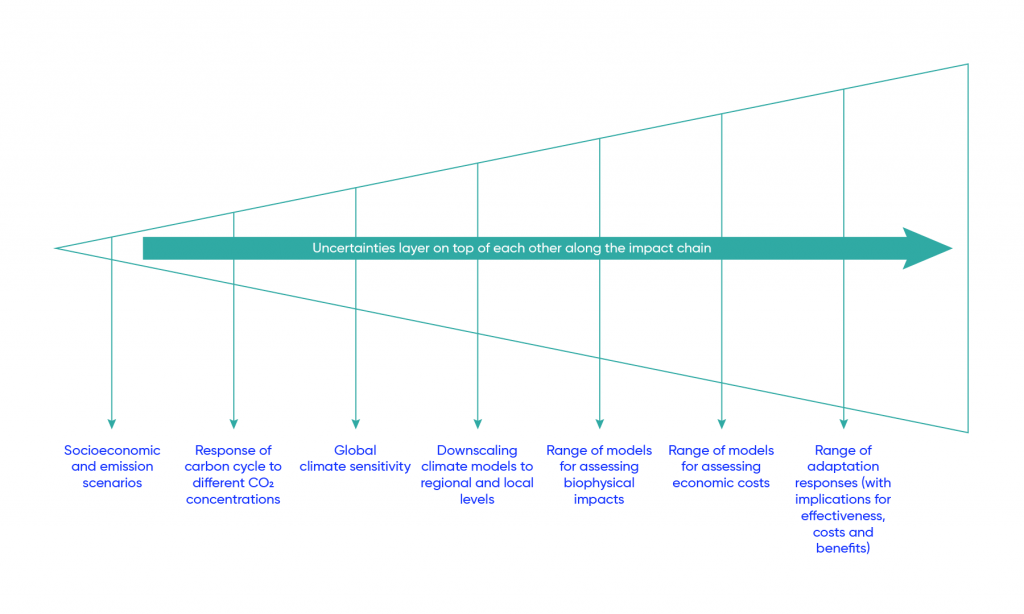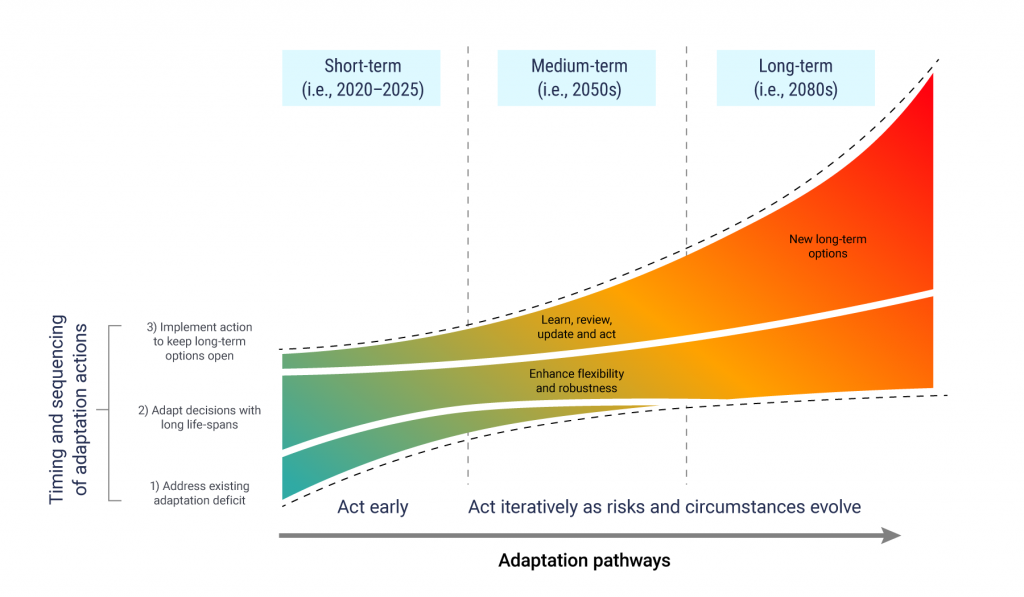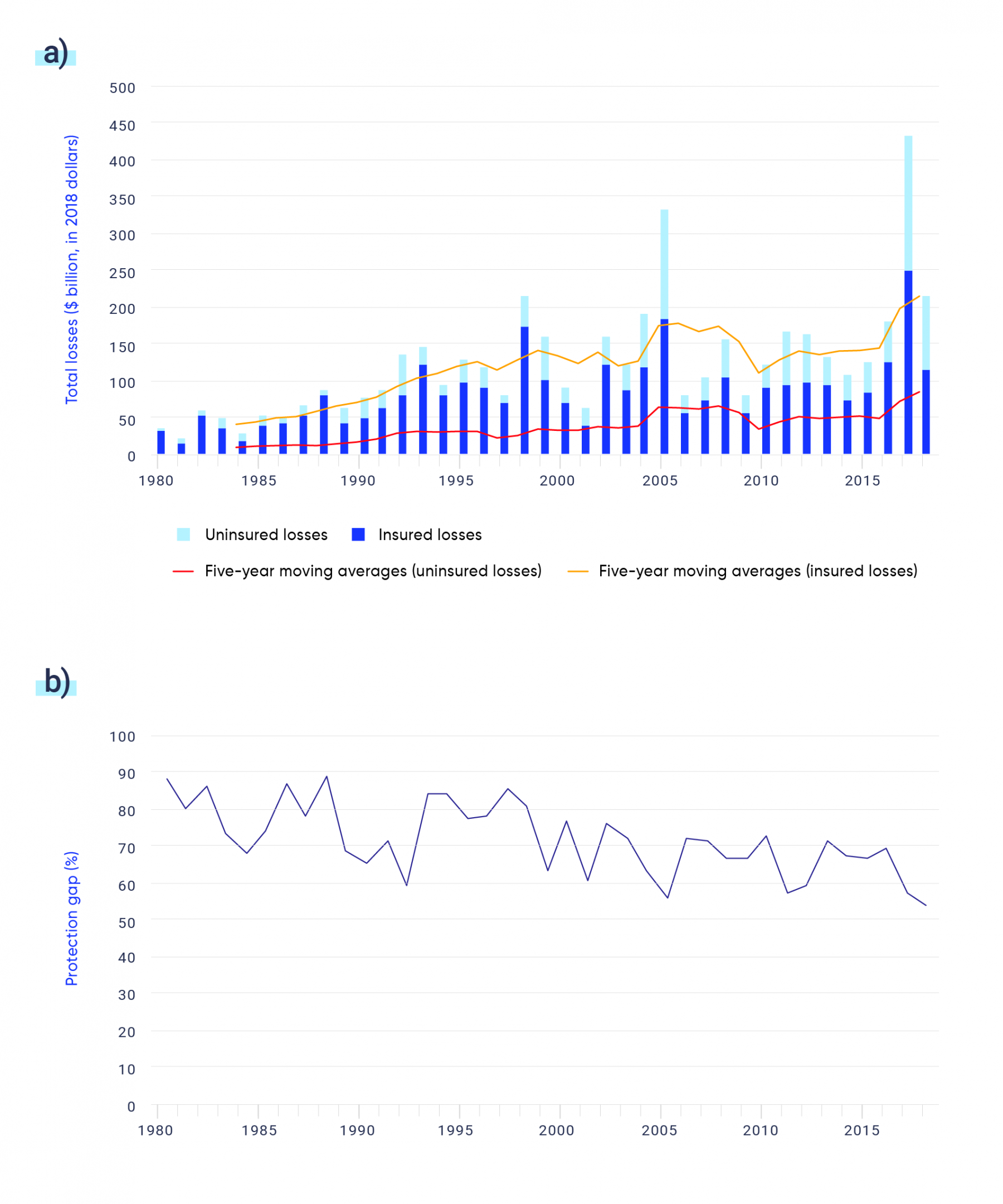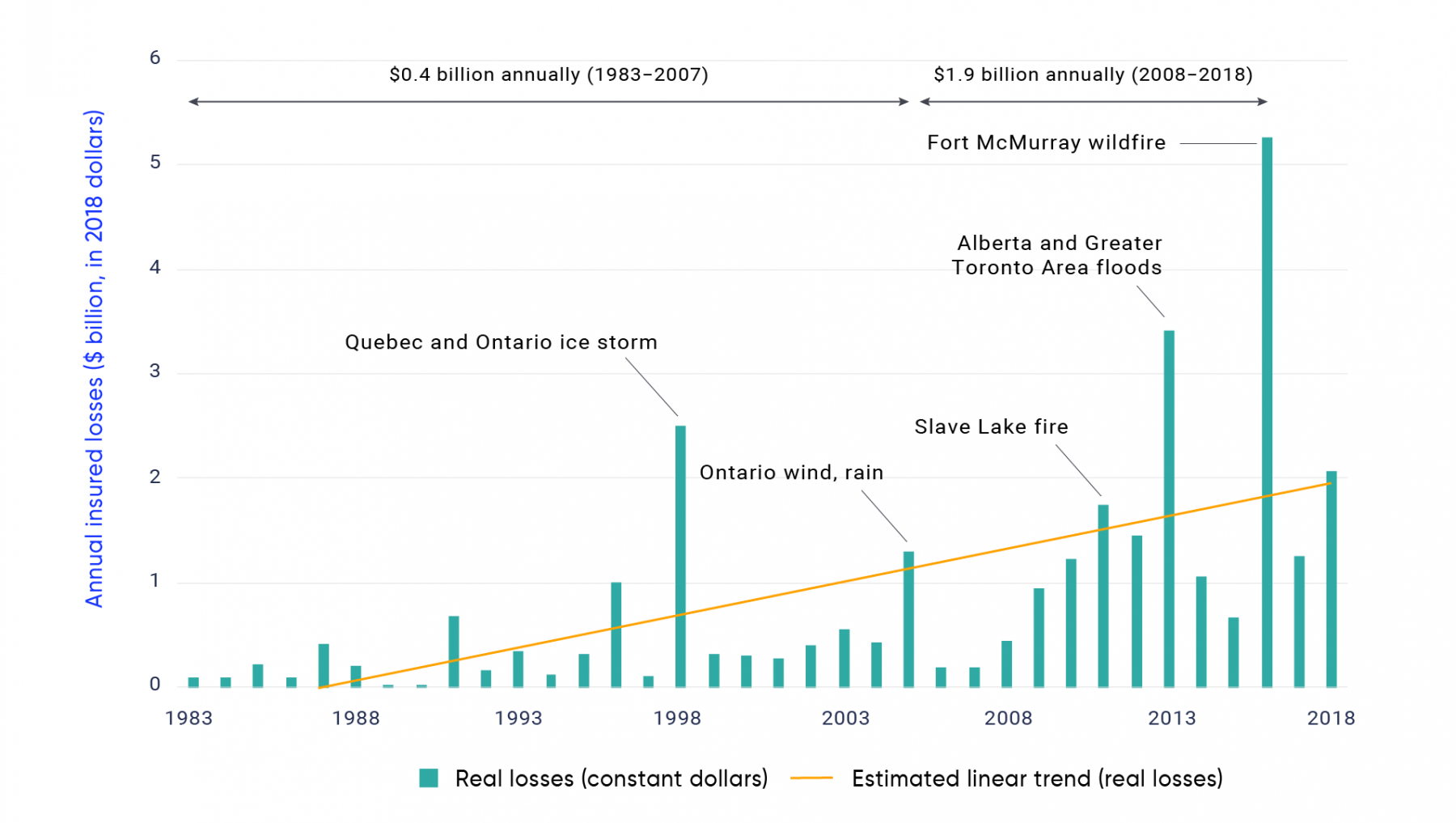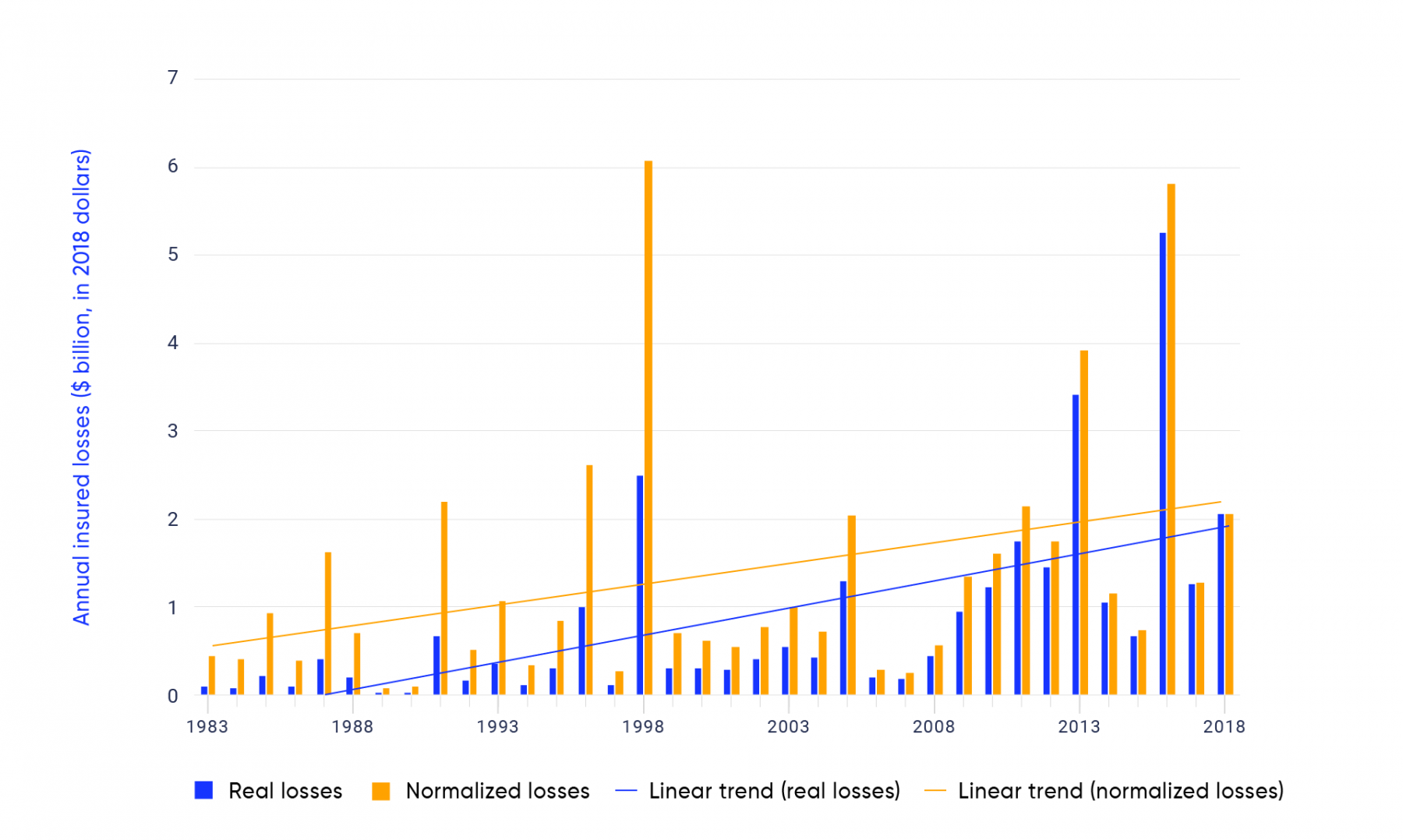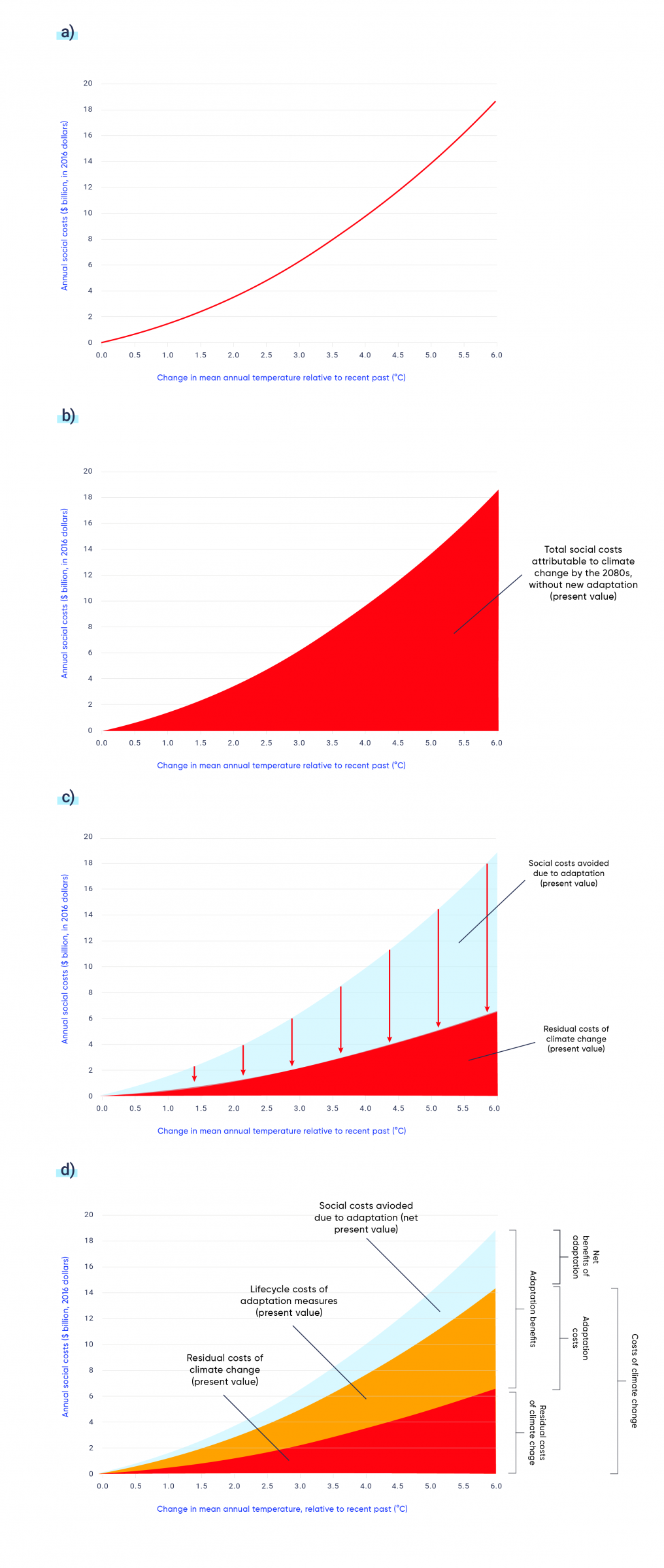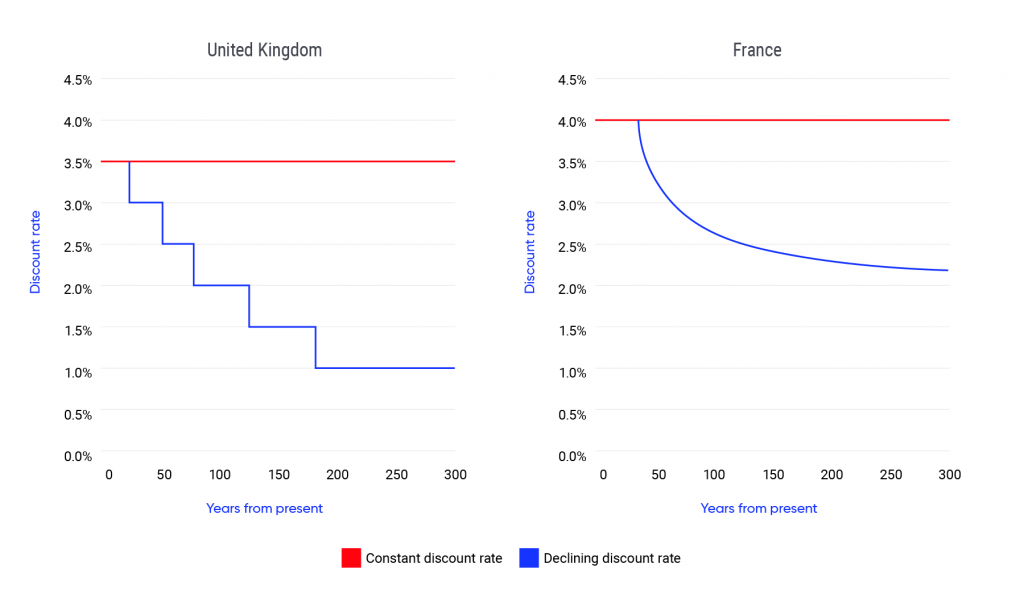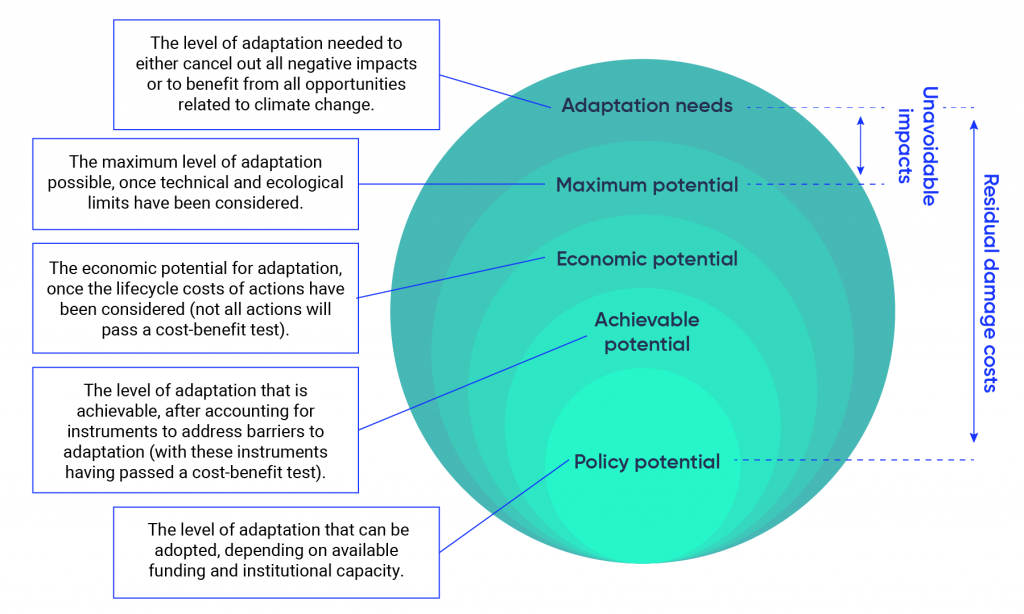Ackerman, F. and Stanton, E. (2006). Climate Change – the Costs of Inaction. Report for Friends of the Earth England, Wales and Northern Ireland. Global Development and Environment Institute, Tufts University, Medford, Massachusetts, 38 p. Retrieved December 2020, from <http://frankackerman.com/publications/climatechange/Climate_Change_Costs_Inaction.pdf>
AGECO Group (2019). Vers de grandes villes résilientes : le coût de l’adaptation aux changements climatiques. Groupe AGECO, Montréal, Quebec, 25 p. Retrieved December 2020, from <https://umq.qc.ca/wp-content/uploads/2019/05/adaptations-chgt-climat-caucus-gdes-viles-10mai19b.pdf>
Agrawala, S., Carraro, C., Bosello, F. and de Bruin, K. (2010). Plan or react? Analysis of adaptation costs and benefits using integrated assessment models, OECD Environment Working Papers No. 23, OECD, Paris, France. Retrieved December 2020, from <https://www.oecd-ilibrary.org/plan-or-react_5km975m3d5hb.pdf?itemId=%2Fcontent%2Fpaper%2F5km975m3d5hb-en&mimeType=pdf>
Agrawala, S., Bosello, F., Carraro, C., De Cian, E., Lanzi, E., de Bruin, K. and Dellink, R.B. (2011). Plan or react? Analysis of adaptation costs and benefits using Integrated Assessment Models. Climate Change Economics, 2(3), 175–208. Retrieved December 2020, from <https://doi.org/10.1142/S2010007811000267>
Alder. M. (2016). Benefit-cost analysis and distributional weights: an overview. Review of Environmental Economics and Policy, 10(2), 264–285. Retrieved December 2020, from <https://scholarship.law.duke.edu/faculty_scholarship/3110>
Amiraslany, A. (2010). The impact of climate change on Canadian agriculture: a Ricardian approach. Doctoral dissertation, Department of Bioresource Policy, Business and Economics, University of Saskatchewan, Saskatoon, Saskatchewan, 169 p. Retrieved December 2020, from <https://harvest.usask.ca/handle/10388/etd-05252010-102012>
Aon (2020). Weather, climate and catastrophic insight: 2019 annual report. Aon plc, Chicago, Illinois, U.S., 80 p. Retrieved December 2020, from <https://www.aon.com/global-weather-catastrophe-natural-disasters-costs-climate-change-2019-annual-report/index.html?utm_source=regionemeauk&utm_campaign=natcat20>
Arrow, K.J., Cline, W.R., Maler, K-G., Munasinghe, M., Squitieri, R. and Stiglitz, J.E. (1996). Intertemporal equity, discounting, and economic efficiency, Chapter 5 in Climate Change 1995: Economic and social dimensions of climate change (Contribution of Working Group III to the Second Assessment Report of the Intergovernmental Panel on Climate Change), (Eds.) J.P. Bruce, H. Lee and E.F. Haites. Cambridge University Press, Cambridge, Massachusetts, 125–144. Retrieved December 2020, from <https://www.ipcc.ch/report/ar2/wg3/#report-chapters>
Arrow, K.J., Cropper, M.L., Gollier, C., Groom, B., Heal, G.M., Newell, R.G., Nordhaus, W.D., Pindyck, R.S., Pizer, W.A., Portney, P.R., Sterner, T., Tol, R.S.J. and Weitzman, M.L. (2012). How should benefits and costs be discounted in an intergenerational context? The views of an expert panel. Resources for the Future Discussion Paper No.12–53, Washington, D.C., 31 p. Retrieved December 2020, from <https://papers.ssrn.com/sol3/papers.cfm?abstract_id=2199511>
Arrow, K.J., Cropper, M.L., Gollier, C., Groom, B., Heal, G.M., Newell, R.G., Nordhaus, W.D., Pindyck, R.S., Pizer, W.A., Portney, P.R., Sterner, T., Tol, R.S.J. and Weitzman, M.L. (2014). Should governments use a declining discount rate in project analysis? Review of Environmental Economics and Policy, 8(2), 145–163. Retrieved December 2020, from <https://doi.org/10.1093/reep/reu008>
Asian Development Bank (2015). Economic analysis of climate-proofing investment projects. Mandaluyong City, Philippines, 85 p. Retrieved December 2020, from <https://www.adb.org/sites/default/files/publication/173454/economic-analysis-climate-proofing-projects.pdf>
Aubé, M., Hébert, C., Wilson, J., Trenholm, R. and Patriquin, M. (2016). Cost benefit analysis of climate change adaptation strategies for the Acadian Peninsula. Green Analytics and the Coastal Zones Research Institute Inc., Shippagan, New Brunswick, 87 p. Retrieved December 2020, from <https://adaptationpa.ca/images/PDF_-_Progression/R-Cost_Benefit_Analysis_of_Climate_Change_Adaptation_Strategies.pdf>
Ayouqi, H. and Vercammen, J. (2014). Evaluating the impact of climate change on Canadian prairie agriculture. Linking Environment and Agriculture Research Network (LEARN). Research Project PR-01-2014, University of British Columbia, Vancouver, 18 p. Retrieved December 2020, from <https://learnnetwork.ualberta.ca/wp-content/uploads/sites/70/2018/07/PR_01_2014_Ayouqi-Vercammen.pdf>
Azfar, O. (1998). Rationalizing hyperbolic discounting. Journal of Economic Behaviour and Organization, 38(2), 245–252. Retrieved April 2021, from <https://doi.org/10.1016/S0167-2681(99)00009-8>
Bain, P.G., Milfont, T.L., Kashima, Y., Bilewicz, M., Doron, G., Garðarsdóttir, R.B., Gouveia, V.V., Guan, Y., Johansson, L-O., Pasquali, C., Corral-Verdugo, V., Aragones, J.I., Utsugi, A., Demarque, C., Otto, S., Park, J., Soland, M., Steg, L., González, R., Lebedeva, N., Madsen, O.J., Wagner, C., Akotia, C.S., Kurz, T., Saiz, J.L., Wesley Schultz, P., Einarsdóttir, G. and Saviolidis, N.M. (2015). Co-benefits of addressing climate change can motivate action around the world. Nature Climate Change, 6, 154–157. Retrieved August 2020, from <https://doi.org/10.1038/nclimate2814>
Berry, P., Yassin, F., Belcher, K. and Lindenschmidt, K. E. (2017a). An economic assessment of local farm multi-purpose surface water retention systems under future climate uncertainty. Sustainability, 9(3), 456. Retrieved August 2020, from <https://doi.org/10.3390/su9030456>
Berry, P., Yassin, F., Belcher, K. and Lindenschmidt, K. E. (2017b). An economic assessment of local farm multi-purpose surface water retention systems in a Canadian Prairie setting. Applied Water Science, 7(8), 4461–4478. Retrieved August 2020, from <https://doi.org/10.1007/s13201-017-0592-7>
Biesbroek, G.R., Klostermann, J.E.M., Termeer, C.J.A.M. and Kabat, P. (2013). On the nature of barriers to climate change adaptation. Regional Environmental Change, 13, 1119–1129. Retrieved August 2020, from <https://doi.org/10.1007/s10113-013-0421-y>
Bloemen, P., Reeder, T., Zevenbergen, C., Rijke, J. and Kingsborough, A. (2018). Lessons learned from applying adaptation pathways in flood risk management and challenges for the further development of this approach. Mitigation and Adaptation Strategies for Global Change, 23, 1083–1108. Retrieved August 2020, from <https://doi.org/10.1007/s11027-017-9773-9>
Boardman, A.E., Moore, M.A. and Vining, A.R. (2008). Social Discount Rates for Canada. University of British Columbia and Simon Fraser University, Vancouver, 28 p. Retrieved December 2020, from <https://www.researchgate.net/publication/236935295_The_Social_Discount_Rate_in_Canada>
Bosello, F., Roson, R. and Tol, R. (2006). Economy-wide estimates of the implications of climate change: human health. Ecological Economics, 58, 579–591. Retrieved December 2020, from <https://doi.org/10.1016/j.ecolecon.2005.07.032>
Bouwer, L.M. (2011). Have disaster losses increased due to anthropogenic climate change? Bulletin of the American Meteorological Society, 92, 39–46. Retrieved December 2020, from <https://doi.org/10.1175/2010BAMS3092.1>
Boyd, R. (2018). Economic impacts of climate change on municipalities: Edmonton case study. Federation of Canadian Municipalities (FCM) Climate and Asset Management Network (CAMN) Webinar, 26th November 2018.
Boyd, R., Gados, A. and Maynes, T. (2013). Economic guidance for the appraisal and prioritization of adaptation actions. Report prepared for the Climate Change Impacts and Adaptation Program of Natural Resources Canada, Climate Change Central, Calgary, Alberta, 242 p.
Boyd, R. and Walton, H. (2006). Water resources, Chapter 9 in Climate change impacts and adaptation: cross-regional research programme project. Report by Metroeconomica Limited (UK) for Department for Environment, Food and Rural Affairs (DEFRA), London, United Kingdom. Retrieved August 2020, from <http://sciencesearch.defra.gov.uk/Default.aspx?Menu=Menu&Module=More&Location=None&Completed=0&ProjectID=13231>
Boyd, R., Zukiwsky, J. and Pringle, T. (2015). Economic tools for climate adaptation: private real estate decisions. Report prepared for the Climate Change Impacts and Adaptation Program of Natural Resources Canada, All One Sky Foundation, Calgary, Alberta, 139 p. Retrieved December 2020, from <https://www.retooling.ca/_Library/ReTooling_Resource_Library/Economic_Tools_for_Climate_Change_Adaptation.pdf>
Boyer-Villemaire, U., Circé, M., Da Silva, L., Desjarlais, C. and Morneau, F. (2016). Atlantic-Quebec cost-benefit analysis of adaptation options in coastal areas: synthesis report. Ouranos, Montréal, 33 p. Retrieved December 2020, from <https://www.ouranos.ca/publication-scientifique/Synthesis-Report-Atl-Qc.pdf>
Braeuninger, M., Butzengeiger-Geyer, S., Dlugolecki, A., Hochrainer-Stigler, S., Koehler, M., Linnerooth-Bayer, J., Mechler, R. and Michaelowa, A. (2011). Application of economic instruments for adaptation to climate change. Final Report, Brussels, Belgium. Retrieved December 2020, from <https://www.researchgate.net/profile/Michael_Braeuninger/publication/248399515_Application_of_economic_instruments_for_adaptation_to_climate_change_Final_report/links/53e0041b0cf2a768e49ea3dc/Application-of-economic-instruments-for-adaptation-to-climate-change-Final-report.pdf>
Brown, C., Werick, W., Leger, W. and Fay, D. (2011). A decision-analytic approach to managing climate risks: application to the Upper Great Lakes. Journal of the American Water Resources Association, 47, 524–534. Retrieved December 2020, from <https://doi.org/10.1111/j.1752-1688.2011.00552.x>
Burton, I. (2009). Climate change and the adaptation deficit, in The Earthscan Reader on Adaptation to Climate Change, (Eds.) L. Shipper and I. Burton. Earthscan, London, United Kingdom, 480 p.
Bush, E. and Lemmen, D. (Eds.), 2019: Canada’s Changing Climate Report, Government of Canada, Ottawa, Ontario, 444 p. Retrieved December 2020, from < https://changingclimate.ca/CCCR2019/>
Butsic, V., Hanak, E. and Valletta, R. (2011). Climate change and housing prices: hedonic estimates for ski resorts in Western North America. Land Economics, 87(1), 75–91. Retrieved December 2020, from <https://doi.org/10.3368/le.87.1.75>
Chambwera, M., Heal, G., Dubeux, C., Hallegatte, S., Leclerc, L., Markandya, A., McCarl, B.A., Mechler, R. and Neumann, J.E. (2014). Economics of adaptation, Chapter 17 in Climate Change 2014: Impacts, Adaptation, and Vulnerability. Part A: Global and Sectoral Aspects (Contribution of Working Group II to the Fifth Assessment Report of the Intergovernmental Panel on Climate Change), (Eds.) C.B. Field, V.R. Barros, D.J. Dokken, K.J. Mach, M.D. Mastrandrea, T.E. Bilir, M. Chatterjee, K.L. Ebi, Y.O. Estrada, R.C. Genova, B. Girma, E.S. Kissel, A.N. Levy, S. MacCracken, P.R. Mastrandrea, and L.L. White. Cambridge University Press, Cambridge, United Kingdom and New York, New York, USA, 945–977. Retrieved December 2020, from <https://www.ipcc.ch/site/assets/uploads/2018/02/WGIIAR5-Chap17_FINAL.pdf>
Chavaillaz, Y., Roy, P., Partanen, A.-I., Da Silva, L., Bresson, É., Mengis, N., Chaumont, D. and Matthews, H.D. (2019). Exposure to excessive heat and impacts on labour productivity linked to cumulative CO2 emissions. Scientific Reports: Nature, 9, 13711. Retrieved December 2020, from <https://doi.org/10.1038/s41598-019-50047-w>
Cimato, F. and Mullan, M. (2010). Adapting to climate change: analysing the role of government. Department for Environment, Food and Rural Affairs (DEFRA), London, United Kingdom, 79 p. Retrieved August 2020, from <https://assets.publishing.service.gov.uk/government/uploads/system/uploads/attachment_data/file/69194/pb13341-analysing-role-government-100122.pdf>
Circé, M., Da Silva, L., Boyer-Villemaire, U., Duff, G., Desjarlais, C. and Morneau, F. (2016a). Cost-benefit analysis for adaptation options in Quebec’s coastal areas – Synthesis Report. Ouranos, Montréal, 89 p. Retrieved August 2020, from <https://www.ouranos.ca/publication-scientifique/Synthesis-Report-Qc.pdf>
Circé, M., Boyer-Villemaire, U., Da Silva, L. and Jardine, D. (2016b). Atlantic-Quebec cost-benefit analysis of coastal adaptation options – integrated results. Ouranos, Montréal, 24 p.
Ciscar, J.-C., Iglesias, A., Feyen, L., Szabó, L., Van Regemorter, D., Amelung, B., Nicholls, R., Watkiss, P., Christensen, O.B., Dankers, R., Garrote, L., Goodess, C.M., Hunt, A., Moreno, A., Richards, J. and Soria, A. (2011). Physical and economic consequences of climate change in Europe. Proceedings of the National Academy of Sciences of the United States of America (PNAS). Retrieved August 2020, from <https://doi.org/10.1073/pnas.1011612108>
Cline, W.R. (2007). Global warming and agriculture: impact estimates by country. Peterson Institute of International Economics, Washington, D.C., 250 p.
Corbett, L.J., Withey, P., Lantz, V.A. and Ochuodho, T.O. (2015). The economic impact of the mountain pine beetle infestation in British Columbia: provincial estimates from a CGE analysis. Forestry, 0, 1–6. Retrieved August 2020, from <https://doi.org/10.1093/forestry/cpv042>
Coronesea, M., Lampertia, F., Kellerc, K., Chiaromontea, F. and Roventinia, A. (2019). Evidence for sharp increase in the economic damages of extreme natural disasters. Proceedings of the National Academy of Sciences of the United States of America (PNAS), 166(43), 21450–21455. Retrieved August 2020, from <https://doi.org/10.1073/pnas.1907826116>
Cropper, M.L., Freeman, M.C., Groom, B. and Pizer, W.A. (2014). Declining discount rates. American Economic Review: Papers and Proceedings, 104(5), 538-543. Retrieved August 2020, from <https://doi.org/10.1257/aer.104.5.538>
Daigle, R. (2012). Sea-level rise and flooding estimates for New Brunswick coastal sections. Report commissioned by the Atlantic Climate Solutions Association, managed by Climate Change Secretariat, New Brunswick Department of Environment, Fredericton, New Brunswick, 45 p. Retrieved August 2020, from <https://atlanticadaptation.ca/fr/islandora/object/acasa%253A569>
Damon, M., Mohlin, K. and Sterner, T. (2013). Putting a price on the future of our children and grand-children, in The globalization of cost–benefit analysis in environmental policymaking, (Eds.) M.A. Livermore and R.L. Revesz. Oxford University Press, New York, 352 p. Retrieved August 2020, from <https://doi.org/10.1093/acprof:oso/9780199934386.001.0001>
DaSilva, L., Desrochers, F.-A., Pineault, K., Gosselin, C.-A., Grenier, P. and Larose, G. (2019). Analyse économique des mesures d’adaptation aux changements climatiques appliquée au secteur du ski alpin au Québec. Ouranos, Montréal, 119 p. Retrieved August 2020, from <https://www.ouranos.ca/publication-scientifique/RapportDaSilva2019.pdf>
de Bruin, K. and Dellink, R. (2011). How harmful are restrictions in adapting to climate change? Global Environmental Change, 21(1), 34–45. Retrieved August 2020, from <https://doi.org/10.1016/j.gloenvcha.2010.09.008>
de Bruin, K. (2011). Distinguishing between proactive (stock) and reactive (flow) adaptation. Centre for Envrionmental and Resource Economics (CERE) Working Papers 2011:8, Umea University, Umea, Sweden, 45 p. Retrieved March 2021, from < http://doi.org/10.2139/ssrn.1854285>
de Bruin, K., Dellink, R. and Agrawala, S. (2009a). Economic aspects of adaptation to climate change: Integrated Assessment Modelling of adaptation costs and benefits. OECD Environment Working Papers No. 6, Organization for Economic Cooperation and Development (OECD), Paris, France, 48 p. Retrieved August 2020, from <https://doi.org/10.1787/225282538105>
de Bruin, K., Dellink, R.B., Ruijs, A., Bolwidt, L., van Buuren, A., Graveland, J., de Groot, R.S., Kuikman, P.J., Reinhard, S., Roetter, R.P., Tassone, A., Verhagen, A. and van Ierland, E.C. (2009b) Adapting to climate change in The Netherlands: an inventory of climate adaptation options and ranking of alternatives. Climatic Change, 95, 23–45. Retrieved August 2020, from <https://doi.org/10.1007/s10584-009-9576-4>
Dell, M., Jones, B.F. and Olken, B.A. (2012). Temperature shocks and economic growth – evidence from the last half century. American Economic Journal: Macroeconomics, 4, 66–95. Retrieved August 2020, from <https://doi.org/10.1257/mac.4.3.66>
Dell, M., Jones, B.F. and Olken, B.A. (2014). What do we learn from the weather? The new climate-economy literature. Journal of Economic Literature, 52, 740–798. Retrieved August 2020, from <https://doi.org/10.1257/jel.52.3.740>
Dennig, F. (2018). Climatic change and the re-evaluation of cost-benefit analysis. Climate Change, 151, 43–54. Retrieved August 2020, from <https://doi.org/10.1007/s10584-017-2047-4>
Dessai, S. and Hulme, M. (2007). Assessing the robustness of adaptation decisions to climate change uncertainties: a case study on water resources management in the East of England. Global Environmental Change, 17(1), 59–72. Retrieved August 2020, from <https://doi.org/10.1016/j.gloenvcha.2006.11.005>
Dessai, S., Hulme, M., Lempert, R.J. and Pielke Jr, R. (2009). Climate prediction: a limit to adaptation? in Adapting to climate change: thresholds, values, governance, (Eds.) W.N. Adger, I. Lorenzoni and K.L. O’Brien. Cambridge University Press, Cambridge, United Kingdom, 49–57.
Dessai, S., Lu, X. and Risbey, J.S. (2005). On the role of climate scenarios for adaptation planning. Global Environmental Change, 15, 87–97. Retrieved August 2020, from <https://doi.org/10.1016/j.gloenvcha.2004.12.004>
Diaz, D. and Moore, F. (2017). Valuing Potential Climate Impacts: A Review of Current Limitations and the Research Frontier. Technical update, product ID 3002011885. Electric Power Research institute (EPRI), Palo Alto, California, 36 p. Retrieved August 2020, from <https://www.epri.com/research/products/3002011885>
Dittrich, R., Wreford, A. and Moran, D. (2016). A survey of decision-making approaches for climate change adaptation: are robust methods the way forward? Ecological Economics, 122, 79–89. Retrieved August 2020, from <https://doi.org/10.1016/j.ecolecon.2015.12.006>
Dorling, R. and Hanniman, K. (2016). Restoring water levels on Lake Michigan-Huron: A cost benefit analysis. Mowat Centre, Munk School of Global Affairs and Public Policy, University of Toronto, Toronto, 74 p. Retrieved August 2020, from <https://munkschool.utoronto.ca/mowatcentre/wp-content/uploads/publications/120_restoring_water_levels_on_lake_michigan-huron.pdf>
Dow, K., Berkhout, F., Preston, B.L., Klein, R.J.T., Midgley G. and Shaw, M.R. (2013). Limits to adaptation. Nature Climate Change, 3, 305–307. Retrieved August 2020, from <https://doi.org/10.1038/nclimate1847>
Downing, T.E. (2012). Views of the frontiers in climate change adaptation economics. WIREs Climate Change, 3(2), 161–170. Retrieved August 2020, from <https://doi.org/10.1002/wcc.157>
Drupp, M., Freeman, M., Groom, B. and Nesje, F. (2015). Discounting disentangled: an expert survey on the determinants of the long-term social discount rate. Working Paper 172. Grantham Research Institute on Climate Change and the Environment, London School of Economics and Political Science, London, United Kingdom, 42 p. Retrieved August 2020, from <http://www.lse.ac.uk/GranthamInstitute/wp-content/uploads/2015/06/Working-Paper-172-Drupp-et-al.pdf>
Dunne, J.P., Stouffer, R.J. and John, J.G. (2013). Reductions in labour capacity from heat stress under climate warming. Nature Climate Change, 3, 563–566. Retrieved August 2020, from <https://doi.org/10.1038/nclimate1827>
Ebi, K., Ogden, N., Semenza, J. and Woodward, A. (2017). Detecting and attributing health burdens to climate change. Environmental Health Perspectives, 125(8), 085004. Retrieved August 2020, from <https://doi.org/10.1289/EHP1509>
Economics of Climate Adaptation (2009). Shaping climate resilient development: a framework for decision-making. A report of the Economics of Climate Adaptation (ECA) Working Group. Swiss Re, McKinsey, Global Environment Facility, European Commission, the Rockefeller Foundation, Climate Works, and Standard Chartered Bank, Zurich, Switzerland, 159 p. Retrieved August 2020, from <http://ccsl.iccip.net/climate_resilient.pdf>
Employment and Social Development Canada (2018). Thermal stress in the workplace: guideline 2018. Employment and Social Development Canada, Ottawa, 30 p. Retrieved August 2020, from <https://www.canada.ca/en/employment-social-development/services/health-safety/reports/thermal-stress-work-place.html>
European Environment Agency (2007). Climate change: the cost of inaction and the cost of adaptation. EEA Technical Report No 13/2007, European Environment Agency (EEA), Copenhagen, Denmark, 67 p. Retrieved August 2020, from <https://www.eea.europa.eu/publications/technical_report_2007_13/at_download/file>
Eisenack, K., Moser, S.C., Hoffman, E., Klein, R.J.T., Oberlack, C., Pechan, A., Rotter, M. and Termeer, C.J.A.M. (2014). Explaining and overcoming barriers to climate change adaptation. Nature Climate Change, 4, 867–872. Retrieved August 2020, from <https://doi.org/10.1038/nclimate2350>
Ekstrom, J., Moser, S. and Torn, M. (2011). Barriers to climate change adaptation: a diagnostic framework. Report prepared for California Energy Commission. Lawrence Berkeley National Laboratory, Berkeley, California. Retrieved August 2020, from <http://www.susannemoser.com/documents/Ekstrom-Moser-Torn_2011_BarriersFrameworkReport_CEC-500-2011-004.pdf>
Epper, T., Fehr-Duda, H. and Bruhin, A. (2011). Viewing the future through a warped lens: Why uncertainty generates hyperbolic discounting? Journal of Risk and Uncertainty, 43, 169–203. Retrieved August 2020, from <https://doi.org/10.1007/s11166-011-9129-x>
Fankhauser, S. (2017). Adaptation to climate change. Annual Review of Resource Economics, 9(1), 209–230. Retrieved August 2020, from <https://doi.org/10.1146/annurev-resource-100516-033554>
Felgenhauer, T. and Webster, M. (2014). Modeling adaptation as a flow and stock decision with mitigation. Climatic Change, 122, 665–679. Retrieved August 2020, from <https://doi.org/10.1007/s10584-013-1016-9>
Filatova, T. (2013). Market-based instruments for flood risk management: a review of theory, practice and perspectives for climate adaptation policy. Environmental Science and Policy, 37, 227–242. Retrieved August 2020, from <https://doi.org/10.1016/j.envsci.2013.09.005>
Filatova, T., Mulder, J. and van der Veen, A. (2011). Coastal risk management: how to motivate individual economic decisions to lower flood risk? Ocean and Coastal Management, 54, 164–172. Retrieved August 2020, from <https://doi.org/10.1016/j.ocecoaman.2010.10.028>
Floater, G., Heeckt, C., Ulterino, M., Mackie, L., Rode, P., Bhardwaj, A., Carvalho, M., Gill, D., Bailey, T. and Huxley, R. (2016). Co-benefits of urban climate action: a framework for cities. A working paper by the Economics of Green Cities Programme, LSE Cities, London School of Economics and Political Science, London, United Kingdom, 86 p. Retrieved August 2020, from <http://eprints.lse.ac.uk/68876/1/Cobenefits_Of_Urban_Climate_Action.pdf>
Fleurbaey, M. and Rafeh, R. (2016). The use of distributional weights in benefit-cost analysis: insights from welfare economics. Review of Environmental Economics and Policy, 10(2), 286–307. Retrieved August 2020, from <https://doi.org/10.1093/reep/rew003>
Food and Agriculture Organization (2007). Adaptation to climate change in agriculture, forestry and fisheries: perspective, framework and priorities. Food and Agriculture Organization (FAO) of the United Nations, Rome, Italy, 24 p. Retrieved August 2020, from <https://www.preventionweb.net/files/8342_j9271e1.pdf>
Fussel, H.-M. (2003). Impacts of climate change on human health — opportunities and challenges for adaptation planning. EVA Working Paper No. 4. Potsdam Institute for Climate Impact Research, Potsdam, Germany.
Gall, M., Borden, K., Emrich, C. and Cutter, S. (2011). The unsustainable trend of natural hazard losses in the United States. Sustainability, 3, 2157–2181. Retrieved August 2020, from <https://doi.org/10.3390/su3112157>
Georgeson, L., Maslin, M., Poessinouw, M. and Howard, S. (2016). Adaptation responses to climate change differ between global megacities. University College London, London, United Kingdom, 15 p. Retrieved August 2020, from <https://doi.org/10.1038/nclimate2944>
Girard, N. (2018). Personal communication with Nicholas Girard, Environmental Policy Analyst, First Nation Adapt Program, Climate Change and Clean Energy Directorate, Natural Resources and Environment Branch, Crown-Indigenous Relations and Northern Affairs Canada, Ottawa, Ontario.
Global Commission in Adaptation (2019). Adapt now: a global call for leadership on climate resilience. Global Commission on Adaptation, 81 p. Retrieved August 2020, from <https://cdn.gca.org/assets/2019-09/GlobalCommission_Report_FINAL.pdf>
Gowdy, J. (2013). Valuing nature for climate change policy: from discounting the future to truly social deliberation, in Handbook on energy and climate change, (Ed.) R. Fouquet. Edward Elgar, Cheltenham, 752 p.
Gregory, R., Failing, L., Harstone, M., Long, G., McDaniels, T. and Ohlson, D. (2012). Structured decision making: a practical guide to environmental management choices. Wiley-Blackwell, Chichester, 315 p.
Groom, B. and Maddison, D. (2018). New estimates of the elasticity of marginal utility for the UK. Environmental and Resource Economics, 72, 1–28. Retrieved August 2020, from <https://doi.org/10.1007/s10640-018-0242-z>
Grothmann, T. and Patt, A. (2005). Adaptive capacity and human cognition: the process of individual adaptation to climate change. Global Environmental Change, 15(3), 199–213. Retrieved August 2020, from <https://doi.org/10.1016/j.gloenvcha.2005.01.002>
Haasnoot, M., Warren, A. and Kwakkel, J.H. (2018). Dynamic adaptive policy pathways (DAPP), in Decision making under deep uncertainty: from theory to practice, (Eds.) V. Marchau, et al. Springer Open Access, Cham, Switzerland, 71-91. Retrieved August 2020, from <https://www.springerprofessional.de/content/pdfId/16610888/10.1007/978-3-030-05252-2_4?canonical=https%3A%2F%2Fwww.springerprofessional.de%2Fen%2Fdynamic-adaptive-policy-pathways-dapp%2F16610888%3FfulltextView%3Dtrue>
Haasnoot, M., Kwakkel, J.H., Walker, W.E. and ter Maat, J. (2013). Dynamic adaptive policy pathways: A method for crafting robust decisions for a deeply uncertain world. Global Environmental Change, 23(2), 485–498. Retrieved August 2020, from <https://doi.org/10.1016/j.gloenvcha.2012.12.006>
Haigh, N. and Fisher, J. (2010). Using a “Real Options” approach to determine a future strategic plan for flood risk management in the Thames Estuary. Government Economic Service Working Paper. Her Majesty’s Treasury, London, United Kingdom.
Hallegatte, S. (2013). The indirect cost of natural disasters and an economic definition of macroeconomic resilience. Impact Appraisal for Sovereign Disaster Risk Financing and Insurance Project: Phase 1 Public Finance and Macroeconomics, Paper 3. Sustainable Development Network, Office of the Chief Economist, The World Bank, Washington, D.C., 35 p. Retrieved December 2020, from <https://openknowledge.worldbank.org/bitstream/handle/10986/22238/The0indirect0c0oeconomic0resilience.pdf?sequence=1&isAllowed=y>
Hallegatte, S. (2014). Trends in hazards and the role of climate change, in Natural disasters and climate change. Springer, Cham, Switzerland, 77–97.
Hallegatte, S., Shah, A., Lempert, R., Brown, C. and Gill, S. (2012). Investment Decision Making Under Deep Uncertainty: Application to Climate Change. Policy Research Working Papers 6193. World Bank, Washington, D.C., 41 p. Retrieved August 2020, from <https://doi.org/10.1596/1813-9450-6193>
Halsnæs, K., Shukla, P., Ahuja,D., Akumu, G., Beale, R., Edmonds, J., Gollier, C., Grübler, A., Ha Duong, M., Markandya, A., McFarland, M., Nikitina, E., Sugiyama, T., Villavicencio A. and Zou, J. (2007). Framing issues, in Climate Change 2007: Mitigation (Contribution of Working Group III to the Fourth Assessment Report of the Intergovernmental Panel on Climate Change), (Eds.) B. Metz, O.R. Davidson, P.R. Bosch, R. Dave and L. A. Meyer. Cambridge University Press, Cambridge, United Kingdom and New York, New York, 118–167. Retrieved August 2020, from <https://www.ipcc.ch/site/assets/uploads/2018/02/ar4-wg3-chapter2-1.pdf>
Hamilton, J., Maddison, D. and Tol, R. (2005). Climate change and international tourism: a simulation study. Global Environmental Change, 15(3), 253–266. Retrieved August 2020, from <https://doi.org/10.1016/j.gloenvcha.2004.12.009>
Heal, G. and Millner, A. (2013). Uncertainty and decision in climate change economics. Grantham Research Institute on Climate Change and the Environment, Working Paper No. 108, London School of Economics, London, United Kingdom, 24 p. Retrieved August 2020, from <https://doi.org/10.1093/reep/ret023>
Heal, G. and Park, J. (2016). Temperature stress and the direct impact of climate change: a review of an emerging literature. Review of Environmental Economics and Policy, 10(2), 1–17. Retrieved August 2020, from <https://doi.org/10.1093/reep/rew007>
Her Majesty’s Government (2013). The national adaptation programme: making the country resilient to a changing climate. Her Majesty’s Government, The Stationery Office, London, United Kingdom, 182 p. Retrieved August 2020, from <https://assets.publishing.service.gov.uk/government/uploads/system/uploads/attachment_data/file/727259/pb13942-nap-20130701.pdf>
Hope, C. (2011). The PAGE09 integrated assessment model: A technical description. Working paper series 4/2011, Judge Business School, University of Cambridge, Cambridge, United Kingdom, 40 p. Retrieved August 2020, from <https://www.jbs.cam.ac.uk/fileadmin/user_upload/research/workingpapers/wp1104.pdf>
Hope, E., McKenney, D., Pedlar, J., Stocks, B. and Gauthier, S. (2015). Wildfire suppression costs for Canada under a changing climate. PLoS ONE, 11(8), e0157425. Retrieved August 2020, from <https://doi.org/10.1371/journal.pone.0157425>
Hotte, N. and Nelson, H. (2015). Economic instruments for adaptation to climate change in forestry. Report prepared for the Climate Change Impacts and Adaptation Program of Natural Resources Canada, University of British Columbia, Vancouver, British Columbia. Retrieved August 2020, from <http://harry-w-nelson-forestry.sites.olt.ubc.ca/files/2015/06/Final-Report-Economic-Instruments-for-Adaptation-to-Climate-Change-June-2-2015.pdf>
Howard, P. and Sylvan, D. (2015). Expert Consensus on the Economics of Climate Change. Institute of Policy Integrity, New York University School of Law, New York, New York, 31 p. Retrieved August 2020, from <https://www.edf.org/sites/default/files/expertconsensusreport.pdf>
Hunt, A. (2009). Economic aspects of climate change impacts and adaptation in the UK. PhD Thesis, University of Bath, Bath, United Kingdom.
IBI Group (2015a). Benefit-cost analysis of flood mitigation projects for the City of Calgary: Glenmore Reservoir diversion. Report prepared for the Government of Alberta by IBI Group, Calgary, Alberta, 9+ p. Retrieved August 2020, from <https://open.alberta.ca/publications/benefit-cost-analysis-of-flood-mitigation-projects-for-the-city-of-calgary-glenmore-reservoir>
IBI Group (2015b). Benefit-cost analysis of flood mitigation projects for the City of Calgary: Springbank off-stream flood storage. Report prepared for the Government of Alberta by IBI Group, Calgary, Alberta, 10+ p. Retrieved August 2020, from <https://open.alberta.ca/dataset/ca7f0d55-e9bc-4efa-8657-9f6014c85f45/resource/e80f53f7-7fd6-45f4-abd7-4ad85d7fd07e/download/springbank-benefit-cost.pdf>
IBI Group (2015c). Benefit-cost analysis of flood mitigation projects for the City of Calgary: McLean Creek flood storage. Report prepared for the Government of Alberta by IBI Group, Calgary, Alberta, 10+ p. Retrieved August 2020, from <https://open.alberta.ca/dataset/33e478fc-1c01-428c-90c7-365e898d969d/resource/58cde7b5-3795-4c25-ba9b-978ef4047ed7/download/mclean-creek-benefit-cost.pdf>
ILO [International Labour Organization] (2019). Working on a warmer planet: the impact of heat stress on labour productivity and decent work. International Labour Organization, Geneva, Switzerland, 103 pp. Retrieved December 2020, from <https://www.ilo.org/wcmsp5/groups/public/—dgreports/—dcomm/—publ/documents/publication/wcms_711919.pdf>
Insurance Bureau of Canada and Federation of Canadian Municipalities (2020). Investing in Canada’s future: the cost of climate adaptation at the local level. Toronto and Ottawa, Ontario, 59 p. Retrieved August 2020, from <https://data.fcm.ca/documents/reports/investing-in-canadas-future-the-cost-of-climate-adaptation.pdf>
Insurance Bureau of Canada (2015). The economic impacts of the weather effects of climate change on communities. Insurance Bureau of Canada, Toronto, Ontario, 201 p. Retrieved August 2020, from <http://assets.ibc.ca/Documents/Studies/IBC-The-Economic-Impacts.pdf>
Insurance Bureau of Canada (2018). 2018 facts of the property and casualty insurance industry in Canada. Insurance Bureau of Canada (IBC), Toronto, Ontario, 69 p. Retrieved August 2020, from <http://assets.ibc.ca/Documents/Facts%20Book/Facts_Book/2018/IBC-Fact-Book-2018.pdf>
Insurance Bureau of Canada (2019). Facts of the Property and Casualty Insurance Industry in Canada, 41st edition. Retrieved June 2020, from <http://assets.ibc.ca/Documents/Facts%20Book/Facts_Book/2019/IBC-2019-Facts.pdf>
IPCC [Intergovernmental Panel on Climate Change] (2001). Climate Change 2001: Impacts, Adaptation, and Vulnerability. Cambridge University Press, Cambridge, United Kingdom and New York, New York, USA, 1032 p. Retrieved August 2020, from <https://www.ipcc.ch/site/assets/uploads/2018/03/WGII_TAR_full_report-2.pdf>
IPCC [Intergovernmental Panel on Climate Change] (2012). Managing the risks of extreme events and disasters to advance climate change adaptation. A Special Report of Working Groups I and II of the Intergovernmental Panel on Climate Change. Cambridge University Press, Cambridge, United Kingdom, and New York, New York, USA, 582 p. Retrieved August 2020, from <https://www.ipcc.ch/site/assets/uploads/2018/03/SREX_Full_Report-1.pdf>
IPCC [Intergovernmental Panel on Climate Change] (2013). Summary for policymakers, in Climate Change 2013: The Physical Science Basis (Contribution of Working Group I to the Fifth Assessment Report of the Intergovernmental Panel on Climate Change), (Eds.) T. Stocker, T., D. Qin, G.-K. Plattner, M. Tignor, S.K. Allen, J. Boschung, A. Nauels, Y. Xia, V. Bex and P.M. Midgley. Cambridge University Press, Cambridge, United Kingdom and New York, New York, USA, 3–29. Retrieved August 2020, from <https://www.ipcc.ch/site/assets/uploads/2018/02/WG1AR5_SPM_FINAL.pdf>
Jenkins, G. and Kuo, C.-Y. (2007). The economic opportunity cost of capital for Canada—an empirical update. Queen’s Economics Department Working Paper Number 1133. Department of Economics, Queen’s University, Kingston, Canada, 25 p. Retrieved August 2020, from <https://www.econ.queensu.ca/sites/econ.queensu.ca/files/qed_wp_1133.pdf>
Jeuland, M. and Whittington, D. (2013). Water resources planning under climate change: assessing the robustness of real options for the Blue Nile. Water Resources Research, 50. Retrieved August 2020, from <https://doi.org/10.1002/2013WR013705>
Johansson-Stenman, O. (2005). Distributional weights in cost-benefit analysis—should we forget about them? Land Economics, 81(3), 337–352. Retrieved August 2020, from <https://www.jstor.org/stable/4129689>
Jones, C.I. and Klenow, P.J. (2016). Beyond GDP? Welfare across countries and time. American Economic Review, 106, 2426–2457. Retrieved August 2020, from <https://doi.org/10.1257/aer.20110236>
Jones, R.N., Patwardhan, A., Cohen, S.J., Dessai, S., Lammel, A., Lempert, R.J., Mirza, M.M.Q. and von Storch, H. (2014). Foundations for decision making, in Climate Change 2014: Impacts, Adaptation, and Vulnerability. Part A: Global and Sectoral Aspects (Contribution of Working Group II to the Fifth Assessment Report of the Intergovernmental Panel on Climate Change), (Eds.) C.B. Field. Cambridge University Press, Cambridge, United Kingdom and New York, New York, USA, 195–228. Retrieved December 2020, from <https://www.ipcc.ch/site/assets/uploads/2018/02/WGIIAR5-Chap2_FINAL.pdf>
Kahn, M.E. (2016). The Climate Change Adaptation Literature. Review of Environmental Economics and Policy, 10(1), 166–178. Retrieved August 2020, from <https://doi.org/10.1093/reep/rev023>
Kahn, M.E., Mohaddes, K., Ng, R.N.C., Hashem Pesaran, M., Raissi, M. and Yang, J.-C. (2019). Long-term macroeconomic effects of climate change: a cross-country analysis. IMF working Paper (WP/19/215), International Monetary Fund (IMF), Washington, D.C., 58 p. Retrieved August 2020, from <https://www.imf.org/-/media/Files/Publications/WP/2019/wpiea2019215-print-pdf.ashx>
Kim, B. and Zauberman, G. (2009). Perception of anticipatory time in temporal discounting. Journal of Neuroscience, Psychology, and Economics, 2, 91–101. Retrieved August 2020, from <https://doi.org/10.1037/a0017686>
Kjellstrom, T., Holmer, I. and Lemke, B. (2009). Workplace heat stress, health and productivity – an increasing challenge for low and middle-income countries during climate change. Global Health Action, 2. Retrieved August 2020, from <https://doi.org/10.3402/gha.v2i0.2047>
Kjellstrom, T., Lemke, B. and Otto, M. (2013). Mapping occupational heat exposure and effects in South-East Asia: Ongoing time trends 1980–2011 and future estimates to 2050. Industrial Health, 51(1), 56–67. Retrieved August 2020, from <https://doi.org/10.2486/indhealth.2012-0174>
Kjellstrom, T., Lemke, B., Matthias Otto, P., Hyatt, O.M., Briggs, D.J. and Freyberg, C.A. (2015). Heat impacts on work, human performance and daily life, in Climate Change and Public Health, (Eds.) B. Levy and J. Patz. Oxford University Press, New York, 73–86. Retrieved August 2020, from <https://doi.org/10.1093/med/9780190202453.003.0004>
Klein, R.J.T., Midgley, G.F., Preston, B.L., Alam, M., Berkhout, F.G.H., Dow, K. and Shaw, M.R. (2014). Adaptation opportunities, constraints and limits, in Climate Change 2014: Impacts, Adaptation, and Vulnerability. Part A: Global and Sectoral Aspects (Contribution of Working Group II to the Fifth Assessment Report of the Intergovernmental Panel on Climate Change), (Eds.) C.B. Field, V.R. Barros, D.J. Dokken, K.J. Mach, M.D. Mastrandrea, T.E. Bilir, M. Chatterjee, K.L. Ebi, Y.O. Estrada, R.C. Genova, B. Girma, E.S. Kissel, A.N. Levy, S. MacCracken, P.R. Mastrandrea, and L.L.White. Cambridge University Press, Cambridge, United Kingdom and New York, New York, USA, 899–943. Retrieved August 2020, from <https://www.ipcc.ch/site/assets/uploads/2018/02/WGIIAR5-Chap16_FINAL.pdf>
Kompass, T., Pham, V. and Che, T. (2018). The effects of climate change on GDP by country and global economic gains from complying with the Paris Accord. Earth’s Future, 6, 1153–1173. Retrieved August 2020, from <https://doi.org/10.1029/2018EF000922>
Kousky, C. (2012). Informing climate adaptation: a review of the economic costs of natural disasters, their determinants, and risk reduction options. RFF DP 12-28. Resources for the Future, Washington, D.C., 62 p. Retrieved August 2020, from <http://dx.doi.org/10.2139/ssrn.2099769>
Kousky, C. (2014). Managing shoreline retreat: a US perspective. Climatic Change, 124, 9–20. Retrieved August 2020, from <https://doi.org/10.1007/s10584-014-1106-3>
Kovats, S., Lloyd, S., Hunt, A. and Watkiss, P. (2011). Technical Policy Briefing Note 5: The Impacts and Economic Costs on Health in Europe and the Costs and Benefits of Adaptation. Results of the EC RTD ClimateCost Project, in The ClimateCost Project, Final Report, Volume 1: Europe, (Ed.) P. Watkiss. Stockholm Environment Institute, Stockholm, Sweden. Retrieved August 2020, from <https://www.sei.org/mediamanager/documents/Publications/sei-climatecost-health.pdf>
Lafakis, C., Ratz, L., Fazio, E. and Cosma, M. (2019). The economic implications of climate change. Moody’s Analytics, London, United Kingdom. Retrieved August 2020, from <https://ma.moodys.com/rs/961-KCJ-308/images/2019-08-08-Climate-Change.pdf>
Lantz, V., Trenholm, R., Wilson, J. and Richards, W. (2012). Assessing market and non-market costs of freshwater flooding due to climate change in the community of Fredericton, Eastern Canada. Climatic Change, 110(1–2), 347–372. Retrieved August 2020, from <https://doi.org/10.1007/s10584-011-0063-3>
Larrivée, C., Desjarlais, C., Roy, R. and Audet, N. (2016). Regional economic study on the potential impacts of climate-change-induced low water levels on the Saint-Laurent River and adaptation options: Synthesis of the findings from six sector-specific studies. Report submitted to Natural Resources Canada’s Climate Change Impacts and Adaptation Division and the Government of Quebec, Ouranos, Montréal. Retrieved August 2020, from <https://www.ouranos.ca/publication-scientifique/ACA-GLSL_synthesis_english_final.pdf>
Larrivée, C., Sinclair-Désgagné, N., Da Silva, L., Revéret, J.P. and Desjarlais, C. (2015). Évaluation des impacts des changements climatiques et de leurs coûts pour le Québec et l’État québécois. Report by Ouranos, Montréal. Retrieved August 2020, from <https://www.ouranos.ca/publication-scientifique/2016/03/RapportLarrivee2015_FR-1.pdf>
Lecocq, F. and Shalizi, Z. (2007). Balancing expenditures on mitigation of adaptation to climate change: an exploration of issues relevant to developing countries. Policy Research Working Paper Series 4299. The World Bank, Washington, D.C. Retrieved August 2020, from <https://openknowledge.worldbank.org/bitstream/handle/10986/7487/wps4299.pdf?sequence=1&isAllowed=y>
Lempert, R.J. (2014). Embedding (some) benefit-cost concepts into decision support processes with deep uncertainty. Journal of Benefit-Cost Analysis, 5(3), 487–514. Retrieved August 2020, from <https://doi.org/10.1515/jbca-2014-9006>
Lempert, R.J., Kalra, N., Peyraud, S., Mao, Z. and Tan, S.B. (2013). Ensuring robust flood risk management in Ho Chi Minh City. Policy Research Working Paper 6465. The World Bank, Washington, D.C., 63 p. Retrieved August 2020, from <https://www.researchgate.net/profile/Dean_Cira/publication/255698092_Ensuring_Robust_Flood_Risk_Management_in_Ho_Chi_Minh_City/links/54e3223e0cf2d90c1d9bff24/Ensuring-Robust-Flood-Risk-Management-in-Ho-Chi-Minh-City.pdf>
Lempert, R., Arnold, J., Pulwarty, R., Gordon, K., Greig, K., Hawkins Hoffman, C., Sands, D. and Werrell, C. (2018). Reducing Risks Through Adaptation Actions, in Impacts, Risks, and Adaptation in the United States: Fourth National Climate Assessment, Volume II, (Eds.) D.R. Reidmiller, C.W. Avery, D.R. Easterling, K.E. Kunkel, K.L.M. Lewis, T.K. Maycock and B.C. Stewart. U.S. Global Change Research Program, Washington, D.C., USA, 1309–1345. Retrieved August 2020, from <https://nca2018.globalchange.gov/downloads/NCA4_Ch28_Adaptation_Full.pdf>
Li, J., Mullan, M. and Helgeson, J. (2014). Improving the practice of economic analysis of climate change adaptation. Journal of Benefit-Cost Analysis, 5(3), 445–467. Retrieved August 2020, from <https://doi.org/10.1515/jbca-2014-9004>
Markandya, A. (2019). Natural Capital and the Rate of Discount, in Mainstreaming Natural Capital and Ecosystem Services into Development Policy, (Ed.) P. Kumar. Routledge Taylor and Francis, London, United Kingdom.
Markandya, A., Galarraga, I. and Sainz de Murieta, S. (Eds.) (2014). Routledge Handbook of the Economics of Climate Change Adaptation. Routledge International Handbooks, Abingdon, United Kingdom, 464 p.
Martinich, J., DeAngelo, B.J., Diaz, D., Ekwurzel, B., Franco, G., Frisch, C., McFarland, J. and O’Neill, B. (2018). Reducing risks through emissions mitigation, in Impacts, Risks, and Adaptation in the United States: Fourth National Climate Assessment, Volume II, (Eds.) D.R. Reidmiller, C.W. Avery, D.R. Easterling, K.E. Kunkel, K.L.M. Lewis, T.K. Maycock and B.C. Stewart. U.S. Global Change Research Program, Washington, D.C., USA, 1346–1386. Retrieved August 2020, from <https://nca2018.globalchange.gov/downloads/NCA4_Ch29_Mitigation_Full.pdf>
Mendelsohn, R. (2012). The economics of adaptation to climate change in developing countries. Climate Change Economics, 3(2). Retrieved August 2020, from <https://doi.org/10.1142/S2010007812500066>
Metroeconomica (2004). Costing the impacts of climate change in the UK: Implementation report. Guidelines prepared for the United Kingdom Climate Impacts Program. Oxford, United Kingdom, 373 p. Retrieved August 2020, from <https://www.ukcip.org.uk/wp-content/PDFs/Costings_Implementation.pdf>
Meyer, V., Gebhardt, O. and Alves, F.A. (Eds.) (2015). Economic evaluation of adaptation options. Bottom-up Climate Adaptation Strategies Towards a Sustainable Europe (BASE Project). Ecologic Institute, Berlin, Germany, 547 p. Retrieved August 2020, from <https://base-adaptation.eu/sites/default/files/Deliverable_5_2_FINAL.pdf>
Miller, S., Muir-Wood, R. and Boissonade, A. (2008). An exploration of trends in normalized weather-related catastrophe losses, in Climate Extremes and Society, (Eds.) H.F. Diaz and R.J. Murnane. Cambridge University Press, New York, 383 p. Retrieved August 2020, from <https://doi.org/10.1017/CBO9780511535840.015>
Millerd, F. (2005). The economic impact of climate change on Canadian commercial navigation on the Great Lake. Canadian Water Resources Journal, 30(4), 269–280. Retrieved August 2020, from <https://doi.org/10.4296/cwrj3004269>
Moser, S.C. and Ekstrom, J.A. (2010). A framework to diagnose barriers to climate change adaptation. Proceedings of the National Academy of Sciences of the United States of America (PNAS), 107(51), 22026–22031. Retrieved August 2020, from <https://doi.org/10.1073/pnas.1007887107>
Moss, R., Scarlett, P.L., Kenney, M.A., Kunreuther, H., Lempert, R., Manning, J., Williams, B.K., Boyd, J.W., Cloyd, E.T., Kaatz, L. and Patton, L. (2014). Decision support: Connecting science, risk perception, and decisions, Chapter 26 in Climate Change Impacts in the United States: The Third National Climate Assessment, (Eds.) J.M. Melillo, T.C. Richmond and G.W. Yohe. U.S. Global Change Research Program, Washington, D.C., 620–647. Retrieved August 2020, from <https://data.globalchange.gov/file/3b8af927-bb15-4eac-8107-860e65e6fc6c>
Moudrak, N., Feltmate, B., Venema, H. and Osman, H. (2018). Combating Canada’s rising flood costs: natural infrastructure is an underutilized option. Report prepared for Insurance Bureau of Canada. Intact Centre on Climate Adaptation, University of Waterloo, Waterloo, Ontario, 66 p. Retrieved August 2020, from <http://assets.ibc.ca/Documents/Resources/IBC-Natural-Infrastructure-Report-2018.pdf>
Munich RE (2018). TOPICS Geo natural catastrophes 2017: a stormy year. Munich RE, Munich, Germany, 64 p. Retrieved August 2020, from <https://www.munichre.com/content/dam/munichre/global/content-pieces/documents/TOPICS_GEO_2017-en.pdf/_jcr_content/renditions/original.media_file.download_attachment.file/TOPICS_GEO_2017-en.pdf>
Munich RE (2020). NatCatSERVICE. Munich Re. Retrieved May 2020, from <https://www.munichre.com/en/solutions/for-industry-clients/natcatservice.html>
National Academies of Sciences, Engineering and Medicine (2016). Attribution of extreme weather events in the context of climate change. The National Academies Press, Washington, D.C., 186 p. Retrieved August 2020, from <https://doi.org/10.17226/21852>
National Centers for Environmental Information (2020). NOAA National Centers for Environmental Information, U.S. Billion-Dollar Weather and Climate Disasters. Retrieved May 2020, from <https://www.ncdc.noaa.gov/billions/>
Neumayer, E. and Barthel, F. (2011). Normalizing economic loss from natural disasters: a global analysis. Global Environmental Change, 21(1), 13–24. Retrieved August 2020, from <https://doi.org/10.1016/j.gloenvcha.2010.10.004>
Newell, R.G. and Pizer, W.A. (2003). Discounting the distant future: How much do uncertain rates increase valuations? Journal of Environmental Economics and Management, 46, 52–71. Retrieved August 2020, from <https://doi.org/10.1016/S0095-0696(02)00031-1>
Newell, R.G., Prest, B.C. and Sexton, S.E. (2018). The GDP-temperature relationship: implications for climate change damages. Resources for the Future Working Paper 18–17, Washington, D.C., 61 p. Retrieved August 2020, from <https://www.rff.org/documents/2655/RFF_WP-18-17_rev_10-20.pdf>
Nordhaus W.D. (2007). A review of the “Stern Review on the Economics of Climate Change.” Journal of Economic Literature, 45, 686–702. Retrieved August 2020, from <https://doi.org/10.1257/jel.45.3.686>
Nordhaus, W.D. and Boyer, J. (2000). Warming the world: economic modeling of global warming. Massachusetts Institute of Technology Press, Cambridge, Massachusetts, 258 p.
National Research Council (2009). Informing Decisions in a Changing Climate. Panel on Strategies and Methods for Climate-Related Decision Support, Committee on the Human Dimensions of Global Change. Division of Behavioral and Social Sciences and Education, The National Academies Press, Washington, D.C., 188 p. Retrieved August 2020, from <https://doi.org/10.17226/12626>
National Research Council (2010). Informing an Effective Response to Climate Change. The National Academies Press, Washington, D.C., 346 p. Retrieved August 2020, from <https://doi.org/10.17226/12784>
NRTEE [National Round Table on the Environment and the Economy] (2011). Paying the price: the economic impacts of climate change for Canada. Ottawa, Ontario, 162 p. Retrieved August 2020, from <http://nrt-trn.ca/wp-content/uploads/2011/09/paying-the-price.pdf>
Office of the Auditor General of Canada (2016). Mitigating the impacts of severe weather events. Spring 2016 Reports of the Commissioner of the Environment and Sustainable Development, Report 2, Ottawa, Ontario, 24 p. Retrieved August 2020, from <https://www.oag-bvg.gc.ca/internet/docs/parl_cesd_201605_02_e.pdf>
Ochuodho, T.O. and Lantz, V.A. (2015). Economic impact of climate change on agricultural crops in Canada by 2051: a global multi-regional CGE model analysis. Environmental Economics, 6(1), 113–125. Retrieved August 2020, from <https://www.businessperspectives.org/index.php/component/zoo/economic-impacts-of-climate-change-on-agricultural-crops-in-canada-by-2051-a-global-multi-regional-cge-model-analysis>
Ochuodho, T.O., Lantz, V.A., Lloyd-Smith, P. and Benitez, P. (2012). Regional economic impacts of climate change and adaptation in Canadian forests: a CGE modeling analysis. Forest Policy and Economics, 25, 100–112. Retrieved August 2020, from <https://doi.org/10.1016/j.forpol.2012.08.007>
Organisation for Economic Co-operation and Development (2015). The Economic Consequences of Climate Change. OECD Publishing, Paris, 140 p. Retrieved August 2020, from <https://dx.doi.org/10.1787/9789264235410-en>
Paci, D. (Ed.) (2014). Human Health Impacts of Climate Change in Europe. Report for the PESETA II Project, JRC Technical Reports, Seville, Spain, 28 p. Retrieved August 2020, from <https://doi.org/10.2791/64481>
Parliamentary Budget Officer (2016). Estimate of the average annual cost of Disaster Financial Assistance Arrangements due to extreme weather. Office of the Parliamentary Budget Officer, Ottawa, Ontario, 46 p. Retrieved August 2020, from <https://www.pbo-dpb.gc.ca/web/default/files/Documents/Reports/2016/DFAA/DFAA_EN.pdf>
Parnham, H., Arnold, S. and Fenech, A. (Eds.) (2016). Using cost–benefit analysis to evaluate climate change adaptation options in Atlantic Canada. Report submitted to Climate Change Impacts and Adaptation Division, Natural Resources Canada, Ottawa, 90 p. Retrieved August 2020, from <https://atlanticadaptation.ca/en/islandora/object/acasa%253A779>
Patt, A. G., van Vuuren, D. P., Berkhout, F., Aaheim, S., Hof, A. F., Isaac, M. and Mechler, R. (2010). Adaptation in integrated assessment modeling: where do we stand? Climatic Change, 99, 383–402. Retrieved August 2020, from <https://doi.org/10.1007/s10584-009-9687-y>
Penning-Rowsell, E.C., Haigh, N., Lavery., S. and McFadden. L. (2013). A threatened world city: the benefits of protecting London from the sea. Natural Hazards, 66, 1383–1404. Retrieved August 2020, from <https://doi.org/10.1007/s11069-011-0075-3>
Perrin, A., Dion, J., Eng, S., Sawyer, D., Nodelman, J. R., Comer, N., Auld, H., Sparling, E., Harris, M., Nodelman, J.Y.H. and Kinnear, L. (2015). Economic implications of climate change adaptations for mine access roads in Northern Canada. Northern Climate ExChange, Yukon Research Centre, Yukon College, 93 p. Retrieved August 2020, from <https://www.yukonu.ca/sites/default/files/inline-files/Economic_Implications_TCWR_FINAL_web3.pdf>
Pielke, R.A. Sr, Wilby, R., Niyogi, D., Hossain, F., Dairuku, K., Adegoke, J., Kallos, G., Seastedt, T. and Suding, K. (2012). Dealing with complexity and extreme events using a bottom-up, resource-based vulnerability perspective, in Extreme events and natural hazards: the complexity perspective. Geophysical Monograph Series 196, 345–359. Retrieved August 2020, from <https://pielkeclimatesci.files.wordpress.com/2012/10/r-3651.pdf>
Pielke, R.A., Jr. (2007). Mistreatment of the economic impacts of extreme events in the Stern Review Report on the Economics of Climate Change. Global Environmental Change, 17, 302–310. Retrieved August 2020, from <https://doi.org/10.1016/j.gloenvcha.2007.05.004>
Pielke, R.A., Jr., Gratz, J., Landsea, C.W., Collins, D., Saunders, M.A. and Musulin, R. (2008). Normalized hurricane damages in the United States: 1900–2005. Natural Hazards Review, 9(1), 29-42. Retrieved August 2020, from <https://doi.org/10.1061/(ASCE)1527-6988(2008)9:1(29)>
Pielke, R.A., Jr., Rubiera, J., Landsea, C., Fernández, M.L. and Klein, R. (2003). Hurricane vulnerability in Latin America and the Caribbean: normalized damages and loss potentials. Natural Hazards Review, 4(3), 101–114. Retrieved August 2020, from <https://doi.org/10.1061/(ASCE)1527-6988(2003)4:3(101)>
Porter, J., Dessai, S. and Tompkins, E. (2014). What do we know about UK household adaptation to climate change? A systematic review. Climatic Change, 127, 371–379. Retrieved August 2020, from <https://doi.org/10.1007/s10584-014-1252-7>
Productivity Commission (2012). Barriers to effective climate change adaptation, Report No. 59, Final Inquiry Report. Productivity Commission, Canberra, Australia, 385 p. Retrieved August 2020, from <https://www.pc.gov.au/inquiries/completed/climate-change-adaptation/report/climate-change-adaptation.pdf>
PROVIA (2013). PROVIA guidance on assessing vulnerability, impacts and adaptation to climate change. Consultation document. United Nations Environment Programme (UNEP), Nairobi, Kenya, 198 p. Retrieved August 2020, from <https://www.adaptation-undp.org/sites/default/files/downloads/provia-guidance-nov2013.pdf>
Public Safety Canada (2020). Canadian Disaster Database (CDD). Retrieved May 2020, from <https://www.publicsafety.gc.ca/cnt/rsrcs/cndn-dsstr-dtbs/index-en.aspx>
Randall, A., Capon, T., Sanderson, T., Merrett, D. and Hertzler, G. (2012). Choosing a decision-making framework to manage uncertainty in climate adaptation decision-making: A practitioner’s handbook. National Climate Change Adaptation Research Facility, Gold Coast, Australia, 25 p. Retrieved May 2020, from <https://www.nccarf.edu.au/sites/default/files/attached_files_publications/Randall_2012_Practitioner_handbook.pdf>
Ranger, N., Millner, A., Dietz, S., Fankhauser, S., Lopez, A. and Ruta, G. (2010). Adaptation in the UK: a decision-making process. Policy Brief. Grantham Research Institute on Climate Change and the Environment, London School of Economics and Political Science, London, United Kingdom, 61 p. Retrieved August 2020, from <https://www.lse.ac.uk/granthaminstitute/publication/adaptation-in-the-uk-a-decision-making-process/>
Ranger, N., Reeder, T. and Lowe, J. (2013). Addressing ‘deep’ uncertainty over long-term climate in major infrastructure projects: four innovations of the Thames Estuary 2100 Project. EURO Journal of Decision Process, 1, 233–262. Retrieved August 2020, from <https://doi.org/10.1007/s40070-013-0014-5>
Ratti, M. (2017). The economics of natural disasters: an overview of the current research issues and methods. CERE Working Paper 2017:3, Centre for Environmental and Resource Economics, Umeå University. Retrieved December 2020, from <http://dx.doi.org/10.2139/ssrn.2957459>
Reeder, T. and Ranger, N. (2011). How do you adapt in an uncertain world? Lessons from the Thames Estuary 2100 project. World Resources Report, Uncertainty Series. World Resources Institute, Washington, D.C., 16 p. Retrieved December 2020, from <https://wriorg.s3.amazonaws.com/s3fs-public/uploads/wrr_reeder_and_ranger_uncertainty.pdf>
Reinsborough, M.J. (2003). A Ricardian model of climate change in Canada. Canadian Journal of Economics, 36(1), 21–40. Retrieved August 2020, from <https://doi.org/10.1111/1540-5982.00002>
Revesz, R.L., Howard, P.H., Arrow, K., Goulder, L.H., Kopp, R.E., Livermore, M.A., Oppenheimer, M. and Sterner, T. (2014). Global warming: Improve economic models of climate change. Nature, 508, 173–175. Retrieved August 2020, from <https://www.nature.com/news/global-warming-improve-economic-models-of-climate-change-1.14991>
Rhodium Group (2014). American climate prospectus: economic risks in the United States. Rhodium Group, New York, New York, 201 p. Retrieved August 2020, from <https://rhg.com/research/american-climate-prospectus-economic-risks-in-the-united-states/>
Rodgers, C. and Douglas, A. (2015). Cost benefit analysis of climate change impacts and adaptation measures for Canadian mines: final report. Report submitted to the Climate Change Impacts and Adaptation Division, Natural Resources Canada, Ottawa, 36 p. Retrieved August 2020, from <http://www.climateontario.ca/doc/p_ECCC/1-AP261-FinalReport-FINAL.PDF>
Rose, A., Porter, K., Dash, N., Bouabid, J., Huyck, C., Whitehead, J., Shaw, D., Eguchi, R., Taylor, C., McLane, T., Thomas Tobin, L., Ganderton, P.T., Godschalk, D., Kiremidjian, A.S., Tierney, K. and West, C. (2007). Benefit-cost analysis of FEMA hazard mitigation grants. Natural Hazards Review, 8(4), 97–111. Retrieved August 2020, from <https://doi.org/10.1061/(ASCE)1527-6988(2007)8:4(97)>
Roson, R. and Sartori, M. (2016). Estimation of climate change damage functions for 140 regions in the GTAP9 database. Policy Research Working Paper 7728, World Bank Group, Washington, D.C., 40 p. Retrieved August 2020, from <https://openknowledge.worldbank.org/handle/10986/24643>
Rosenzweig, C. and Solecki, W. (2014). Hurricane Sandy and adaptation pathways in New York: lessons from a first-responder city. Global Environmental Change, 28, 395–408. Retrieved August 2020, from <https://doi.org/10.1016/j.gloenvcha.2014.05.003>
Rouillard, J., Tröltzsch, J., Tarpey, J., Lago, M., Watkiss, P., Hunt, A. Bosello, F., Ermolieva, T., Goodess, C., Mechler, R., Parrado, R., Sainz de Murieta, E. and Scussolini, P. (2016a). The economic analysis of climate adaptation: insights for policy-makers. ECONADAPT project, University of Bath, Bath, United Kingdom, 45 p. Retrieved August 2020, from <https://econadapt.eu/sites/default/files/docs/Deliverable%2010-3.pdf>
Rouillard, J., Tröltzsch, J., Lago, M., Markandya, A., Sainz de Murieta, E. and Galarraga, I. (2016b). Distributional objectives and monetary metrics. ECONADAPT project, University of Bath, Bath, United Kingdom, 60 p. Retrieved August 2020, from <https://www.ecologic.eu/14384>
Schipper, L. and Pelling, M. (2006). Disaster risk, climate change and international development: Scope for, and challenges to, integration. Disasters, 30, 19–38. Retrieved August 2020, from <https://doi.org/10.1111/j.1467-9523.2006.00304.x>
Schmidt, S., Kemfert, C. and Hoppe, P. (2009). Tropical cyclone losses in the USA and the impact of climate change—a trend analysis based on data from a new approach to adjusting storm losses. Environmental Impact Assessment Review, 29, 359–369. Retrieved August 2020, from <https://doi.org/10.1016/j.eiar.2009.03.003>
Scussolini, P., Kuik, O., Veldkamp, T., Hudson, P., Sainz de Murieta, E., Galarraga, I., Kaprová, K., Melichar, J., Lago, M., Rouillard, J., Troeltzsch, J., Hunt, A., Skourtos, M., Goodess, C. and Christensen, O. (2015). The economic appraisal of adaptation investments under uncertainties: policy recommendations, lessons learnt and guidance. ECONADAPT project, University of Bath, Bath, United Kingdom, 37 p. Retrieved August 2020, from <https://econadapt.eu/sites/default/files/docs/Deliverable%206-4%20approved%20for%20publishing.pdf>
Settle, C. and Shogren, J. (2004). Hyperbolic discounting and time inconsistency in a native exotic species conflict. Resource and Energy Economics, 26, 255–274. Retrieved August 2020, from <https://doi.org/10.1016/j.reseneeco.2003.11.010>
Smith, A.B. and Katz, R. (2013). U.S. billion-dollar weather and climate disasters: data sources, trends, accuracy and biases. Natural Hazards, 67, 387–410. Retrieved August 2020, from <https://doi.org/10.1007/s11069-013-0566-5>
Sozou, P. (1998). On hyperbolic discounting and uncertain hazard rates. Proceedings of the Royal Society, 265(1409), 2015-2020. Retrieved August 2020, from <https://doi.org/10.1098/rspb.1998.0534>
Squire, L. and van der Tak, H. (1975). Economic analysis of projects. Johns Hopkins Press, Baltimore, Maryland, USA, 153 p.
Stern N. (2008). The economics of climate change. The American Economic Review, 98, 1–37. Retrieved August 2020, from <https://doi.org/10.1257/aer.98.2.1>
Stern, N. (2006). The economics of climate change: Stern review. Cambridge University Press, Cambridge, United Kingdom, 662 p. Retrieved August 2020, from <https://webarchive.nationalarchives.gov.uk/20100407172811/http://www.hm-treasury.gov.uk/stern_review_report.htm>
Stern, N. (2013). The structure of economic modeling of the potential impacts of climate change: grafting gross underestimation of risk onto already narrow science models. Journal of Economic Literature, 51(3), 838–859. Retrieved August 2020, from <https://doi.org/10.1257/jel.51.3.838>
Sussman, F., Krishnan, N., Maher, K., Miller, R., Mack, C., Stewart, P., Shouse, K. and Perkins, B. (2014). Climate change adaptation cost in the US: What do we know? Climate Policy, 14(2), 242–282. Retrieved August 2020, from <https://doi.org/10.1080/14693062.2013.777604>
Swart, R.J. and Singh, T. (2013). Mediation and the adaptation challenge: identifying appropriate methods and tools to support climate change adaptation decision making. Alterra, Wageningen University and Research, Wageningen, the Netherlands, 32 p. Retrieved August 2020, from <http://www.rec.org/publication.php?id=392>
Swiss Re Institute (2018). Sigma, natural catastrophes and man-made disasters in 2017: a year of record-breaking losses. Sigma No. 1/2018. Swiss Re Institute, Zurich, Switzerland, 53 p. Retrieved August 2020, from <https://www.swissre.com/institute/research/sigma-research/sigma-2018-01.html#:~:text=sigma%20research-,sigma%201%2F2018%3A%20Natural%20catastrophes%20and%20man%2Dmade%20disasters,recorded%20in%20a%20single%20year>
Swiss Re Institute (2019a). Sigma, natural catastrophes and man-made disasters in 2018: secondary perils on the frontline. Sigma No. 2/2019. Swiss Re Institute, Zurich, Switzerland, 30 p. Retrieved August 2020, from <https://www.swissre.com/dam/jcr:c37eb0e4-c0b9-4a9f-9954-3d0bb4339bfd/sigma2_2019_en.pdf>
Swiss Re Institute (2019b). Sigma, world insurance: the great pivot east continues. Sigma No. 3/2019. Swiss Re Institute, Zurich, Switzerland, 45 p.
Swiss Re Institute (2020). Natural catastrophes in times of economic accumulation and climate change. Swiss Re Sigma No. 2/2020. Swiss Re Institute, Zurich, Switzerland, 31 p. Retrieved August 2020, from <https://www.swissre.com/institute/research/sigma-research/sigma-2020-02.html>
TBS [Treasury Board of Canada Secretariat] (2018). Policy on Cost-Benefit Analysis. Treasury Board of Canada Secretariat, Ottawa, ON. Retrieved April 2021, from <https://www.canada.ca/en/government/system/laws/developing-improving-federal-regulations/requirements-developing-managing-reviewing-regulations/guidelines-tools/policy-cost-benefit-analysis.html>
TBS [Treasury Board of Canada Secretariat] (2007). Canadian Cost-Benefit Analysis Guide. September 2018 revision. Treasury Board of Canada Secretariat, Ottawa, ON, 47 p. Retrieved August 2020, from <https://www.tbs-sct.gc.ca/rtrap-parfa/analys/analys-eng.pdf>
Thistlethwaite, J., Minano, A., Blake, J.A., Henstra, D. and Scott, D. (2018). Application of re/insurance models to estimate increases in flood risk due to climate change. Geoenvironmental Disasters, 8(8). Retrieved August 2020, from <https://doi.org/10.1186/s40677-018-0101-9>
Tröltzsch, J., Rouillard, J., Tarpey, J., Lago, M., Watkiss, P. and Hunt, A. (2016). The economics of climate change adaptation: insights into economic assessment methods. ECONADAPT project, University of Bath, Bath, United Kingdom, 42 p. Retrieved August 2020, from <https://econadapt.eu/sites/default/files/docs/Deliverable%2010-2.pdf>
United Nations Environment Programme (2011). A practical framework for developing pro-climate development policy. United Nations Environment Programme (UNEP), Nairobi, Kenya, 142 p. Retrieved December 2020, from <https://www.unenvironment.org/resources/report/practical-framework-planning-pro-development-climate-policy>
UNFCCC [United Nations Framework Convention on Climate Change] (2007). Investment and financial flows to address climate change. UNFCCC, Climate Change Secretariat, Bonn, Germany, 262 p. Retrieved August 2020, from <https://unfccc.int/resource/docs/publications/financial_flows.pdf>
Urge-Vorsatz, D., Tirado-Herrero, S. and Dubash, N. (2014). Measuring the co-benefits of climate change mitigation. Annual Review of Environment and Resources, 39(1), 549–582. Retrieved December 2020, from <https://doi.org/10.1146/annurev-environ-031312-125456>
USAID (2013). Methods for economic analysis of climate change adaptation interventions. Washington, D.C., 60 p. Retrieved December 2020, from <https://www.climatelinks.org/sites/default/files/asset/document/Methods%2520of%2520Economic%2520Analysis_CLEARED.pdf>
US Environmental Protection Agency (2007). Guide to resource planning with energy efficiency. A resource of the national action plan for energy efficiency, US Environmental Protection Agency, Washington, D.C., 81 p. Retrieved August 2020, from <https://www.epa.gov/sites/production/files/2015-08/documents/resource_planning.pdf>
US Environmental Protection Agency (2015). Climate change in the United States: benefits of global action. US Environmental Protection Agency, Office of Atmospheric Programs, EPA 430-R-15-001. Washington, D.C. Retrieved August 2020, from <https://www.epa.gov/cira/downloads-cira-report>
US Environmental Protection Agency (2017). Multi-model Framework for Quantitative Sectoral Impacts Analysis: A Technical Report for the Fourth National Climate Assessment. EPA 430-R-17-001. U.S. Environmental Protection Agency (EPA), Washington, D.C., 271 p. Retrieved August 2020, from <https://cfpub.epa.gov/si/si_public_file_download.cfm?p_download_id=537327&Lab=OAP>
U.S. Global Change Research Program (2018). Impacts, risks, and adaptation in the United States: Fourth National Climate Assessment, Volume II, (Eds.) D.R. Reidmiller, C.W. Avery, D.R. Easterling, K.E. Kunkel, K.L.M. Lewis, T.K. Maycock, and B.C. Stewart. U.S. Global Change Research Program, Washington, D.C., 1515 p. Retrieved August 2020, from <http://doi.org/10.7930/NCA4.2018>
Van der Geest, K. and Warner, K. (2015). Editorial: loss and damage from climate change: emerging perspectives. International Journal of Global Warming, 8(2), 133–140. Retrieved August 2020, from < https://www.researchgate.net/profile/Kees-Van-Der-Geest/publication/282322818_Editorial_Loss_and_damage_from_climate_change_Emerging_perspectives/links/560bac8108ae7fa7b886e9ea/Editorial-Loss-and-damage-from-climate-change-Emerging-perspectives.pdf>
van der Pol, T.D., van Ierland, E. and Weikard, H.-P. (2013). Optimal dike investments under uncertainty and learning about increasing water levels. Journal of Flood Risk Management, 7(4), 308–318. Retrieved August 2020, from <https://doi.org/10.1111/jfr3.12063>
Vanos, J., Vecellio, D.J. and Kjellstrom, T. (2019). Workplace heat exposure, health protection, and economic impacts: a case study in Canada. American Journal of Industrial Medicine, 62(12), 1024–1037. Retrieved August 2020, from <https://doi.org/10.1002/ajim.22966>
Vivid Economics (2013). The macroeconomics of climate change. Report prepared for the UK Department for Environment, Food and Rural Affairs, London, United Kingdom. 95 p. Retrieved August 2020, from <http://randd.defra.gov.uk/Document.aspx?Document=11138_TheMacroeconomicsofClimateChangeFinalReportMay2013.pdf>
Wallimann-Helmer, I., Meyer L., Mintz-Woo K., Schinko T. and Serdeczny O. (2019). The ethical challenges in the context of climate loss and damage, in Loss and damage from climate change, (Eds.) R. Mechler, L. Bouwer, T. Schinko, S. Surminski, J. Linnerooth-Bayer. Climate Risk Management, Policy and Governance, Springer Open, Cham, Switzerland, 39–62. Retrieved August 2020, from <https://doi.org/10.1007/978-3-319-72026-5_2>
Walker, W.E., Haasnoot, M. and Kwakkel, J. H. (2013). Adapt or perish: a review of planning approaches for adaptation under deep uncertainty. Sustainability, 5, 955–979. Retrieved August 2020, from <https://doi.org/10.3390/su5030955>
Wang, W. and McCarl, B. (2011). Temporal investment in climate change adaptation and mitigation. Climate Change Economics, 4(2). Retrieved August 2020, from <https://doi.org/10.1142/S2010007813500097>
Warren, R., Andrews, O., Brown, S., Forstenhaeusler, N., Gernaat, D., Goodwin, P., Harris, I., He, H., Hope, C., Gonzalex-Colon, F., Nicholls, R., Osborn, T., Price, J., Van Vuuren, D. and Wright, R. (2018). Risks associated with global warming of 1.5°C or 2°C. Briefing Note, Tyndall Centre for Climate Change Research, University of East Anglia. Retrieved December 2020, from <https://tyndall.ac.uk/sites/default/files/publications/briefing_note_risks_warren_r1-1.pdf>
Watkiss, P. (2015). A review of the economics of adaptation and climate-resilient development. Grantham Research Institute on Climate Change and the Environment Working Paper No. 205. Grantham Research Institute on Climate Change and the Environment, London School of Economics, London, United Kingdom, 41 p. Retrieved August 2020, from <https://www.lse.ac.uk/granthaminstitute/wp-content/uploads/2015/09/Working-Paper-205-Watkiss.pdf>
Watkiss, P., Hunt, A., Blyth, W. and Dyszynski, J. (2015a). The use of new economic decision support tools for adaptation assessment: a review of methods and applications, towards guidance on applicability. Climatic Change, 132(3), 401–416. Retrieved August 2020, from <https://doi.org/10.1007/s10584-014-1250-9>
Watkiss, P. and Hunt, A. (2013). Method overview: decision support methods for adaptation. Briefing Note 1. Summary of methods and case study examples from the MEDIATION Project. Alterra, Wageningen University and Research, Wageningen, the Netherlands. Retrieved August 2020, from <https://www.sei.org/mediamanager/documents/Publications/sei-mediation-briefing1-method-overview.pdf>
Watkiss, P., Hunt, A. and Savage, M. (2014). Early value for money adaptation toolkit: delivering value-for-money adaptation with iterative frameworks and low-regret options. UK Department for International Development (DFID), London, United Kingdom, 118 p. Retrieved August 2020, from <https://assets.publishing.service.gov.uk/media/57a089a9ed915d622c00033b/Early_VfM_Adaptation_Final_Report.pdf>
Weaver, C.P., Lempert, R.J., Brown, C., Hall, J.A., Revell, D. and Sarewitz, D. (2013). Improving the contribution of climate model information to decision making: The value and demands of robust decision frameworks. Wiley Interdisciplinary Reviews: Climate Change, 4(1), 39–60. Retrieved August 2020, from <https://doi.org/10.1002/wcc.202>
Weber, M. and Hauer, G. (2003) A regional analysis of climate change impacts on Canadian agriculture. Canadian Public Policy, 29(2), 163–180. Retrieved August 2020, from <https://doi.org/10.2307/3552453>
Weiland, S. and Tröltzsch, J. (Eds.) (2015). BASE evaluation criteria for climate adaptation. Bottom-up Climate Adaptation Strategies Towards a Sustainable Europe (BASE Project). Ecologic Institute, Berlin, Germany, 134 p. Retrieved August 2020, from <https://base-adaptation.eu/sites/default/files/BASE_Policy_3_June_2015_0.pdf>
Weitzman M.L. (2007). A review of the Stern Review on the Economics of Climate Change. Journal of Economic Literature, 45, 703–724. Retrieved August 2020, from <https://www.aeaweb.org/articles?id=10.1257/jel.45.3.703>
Weitzman, M.L. (2001). Gamma discounting. American Economic Review, 91(1), 261–271. Retrieved August 2020, from <https://doi.org/10.1257/aer.91.1.260>
Wilby, R. and Dessai, S. (2010). Robust adaptation to climate change. Weather, 65, 180–185. Retrieved December 2020, from <https://doi.org/10.1002/wea.543>
Wilby, R. (2012). Frameworks for delivering regular assessments of the risks and opportunities from climate change. An independent review of the first UK Climate Change Risk Assessment. Final report to the Committee on Climate Change, London, United Kingdom.
Wilson, J., Trenholm, R., Bornemann, J. and Lieske, D. (2012). Forecasting economic damages from storm surge flooding: a case study in the Tantramar Region of New Brunswick. Report prepared for the Atlantic Climate Solutions Association (ACASA) by Green Analytics and the Department of Geography and Environment. Mount Allison University, Sackville, New Brunswick, 59 p. Retrieved August 2020, from <https://atlanticadaptation.ca/en/islandora/object/acasa%253A722>
Wise, R.M., Fazey, I., Stafford Smith, M., Park, S.E., Eakin, H.C., Archer Van Garderen, E.R.M. and Campbell, B. (2014). Reconceptualising adaptation to climate change as part of pathways of change and response. Global Environmental Change, 28, 325–336. Retrieved August 2020, from <https://doi.org/10.1016/j.gloenvcha.2013.12.002>
Withey, P., Lantz, V. and Ochuodho, T. (2016). Economic costs and impacts of climate-induced sea-level rise and storm surge in Canadian coastal provinces: a CGE approach. Applied Economics, 48(1), 59–71. Retrieved August 2020, from <https://doi.org/10.1080/00036846.2015.1073843>
Withey, P., Ochuodho, T. and Lantz, V. (2015). The economic impact of the mountain pine beetle infestation in British Columbia: Provincial estimates from a CGE analysis. Forestry, 89(1), 100–105. Retrieved August 2020, from <https://doi.org/10.1093/forestry/cpv042>
Woodward, M., Gouldby, B., Kapelan, Z., Khu, S-T. and Townend, I. (2011). Incorporating real options into flood risk management decision-making. HR Wallingford, Wallingford, United Kingdom. Retrieved August 2020, from <https://www.researchgate.net/profile/Ian_Townend/publication/279476752_Incorporating_real_options_into_flood_risk_management_decision_making/links/55cb0f9508aeb975674a62f9/Incorporating-real-options-into-flood-risk-management-decision-making.pdf>
Zhai, F., Lin, T. and Byambadorj, E. (2009). A general equilibrium analysis of the impact of climate change on agriculture in the People’s Republic of China. Asian Development Review, 26(1), 206–225. Retrieved August 2020, from <https://www.researchgate.net/profile/Fan_Zhai3/publication/227488886_A_General_Equilibrium_Analysis_of_the_Impact_of_Climate_Change_on_Agriculture_in_the_People’s_Republic_of_China/links/547706780cf2778985b0a0a1/A-General-Equilibrium-Analysis-of-the-Impact-of-Climate-Change-on-Agriculture-in-the-Peoples-Republic-of-China.pdf>
Zhang, X., Flato, G., Kirchmeier-Young, M., Vincent, L., Wan, H., Wang, X., Rong, R., Fyfe, J., Li, G. and Kharin, V.V. (2019). Temperature and Precipitation Across Canada, Chapter 4 in Canada’s Changing Climate Report, (Eds.) E. Bush and D.S. Lemmen. Government of Canada, Ottawa, Ontario, 112–193. Retrieved August 2020, from <https://www.nrcan.gc.ca/sites/www.nrcan.gc.ca/files/energy/Climate-change/pdf/CCCR_Chapter4-Temperature%20and%20Precipitation%20Across%20Canada.pdf>
Zivin, J. and Neidell, M. (2014). Temperature and the allocation of time: Implications for climate change. Journal of Labor Economics, 32(1), 1–26. Retrieved August 2020, from <https://doi.org/10.1086/671766>

